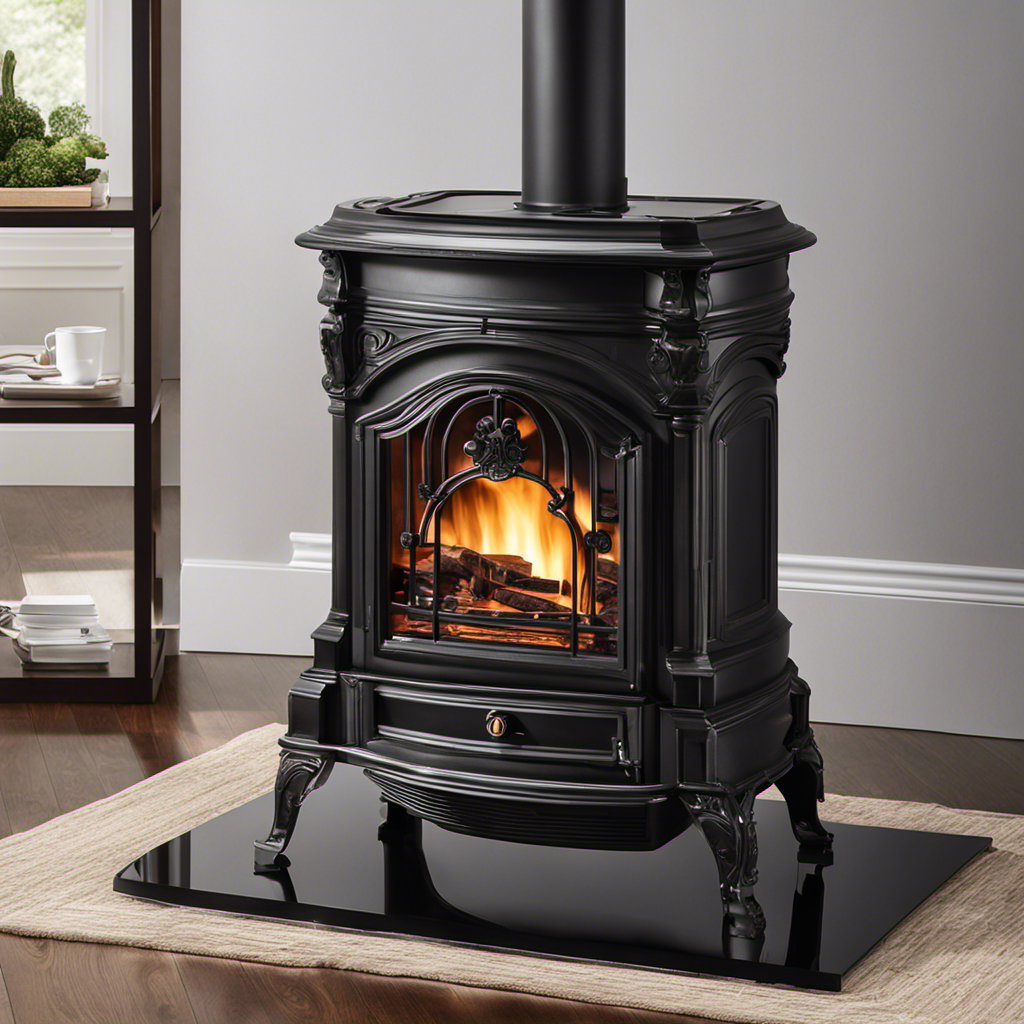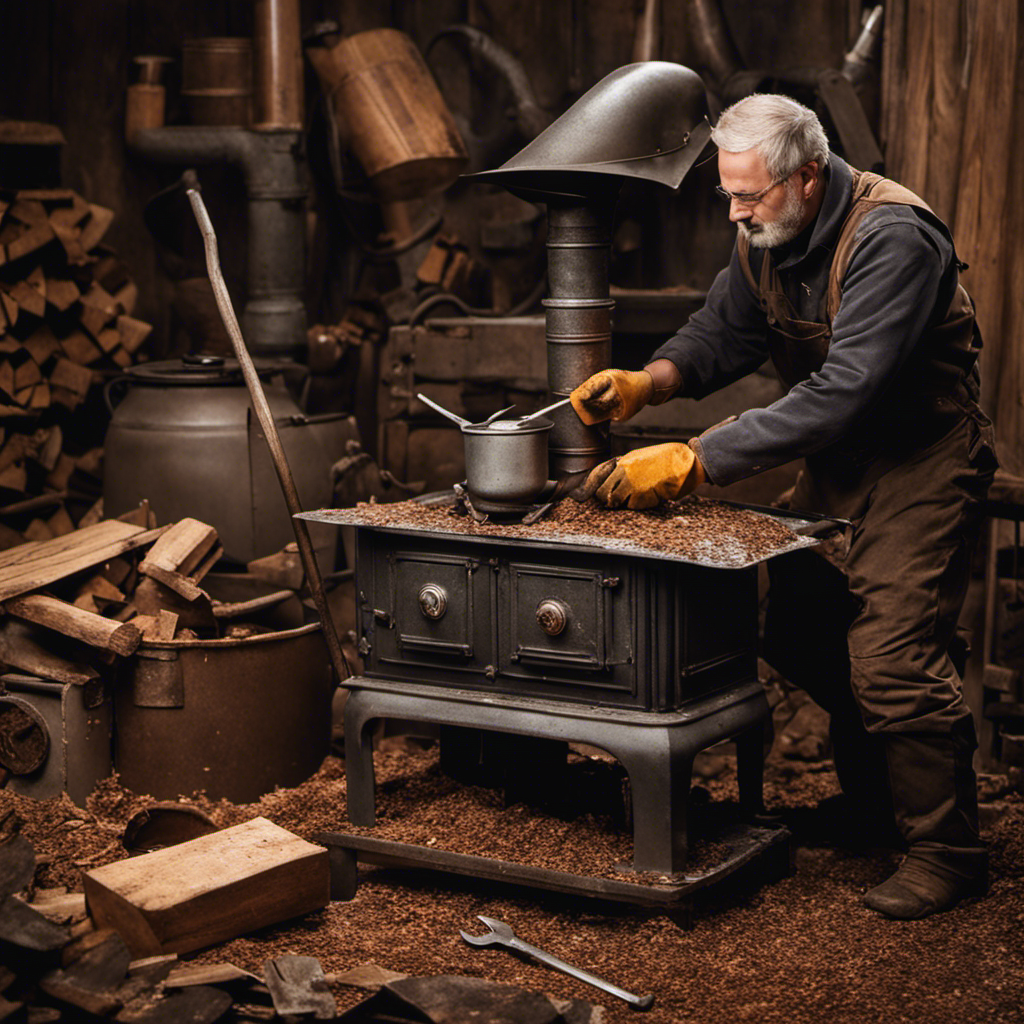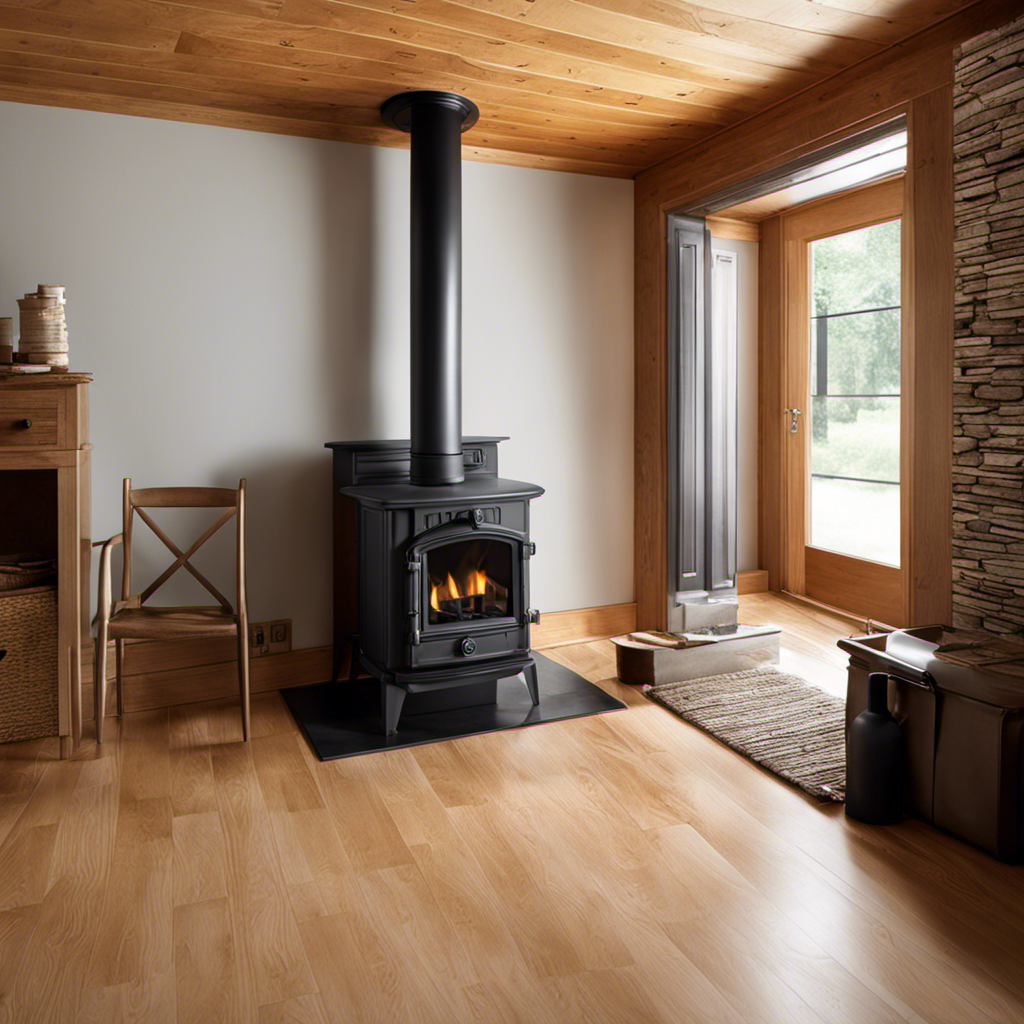Wood Stove
How To Keep Wood Stove Burning All Night
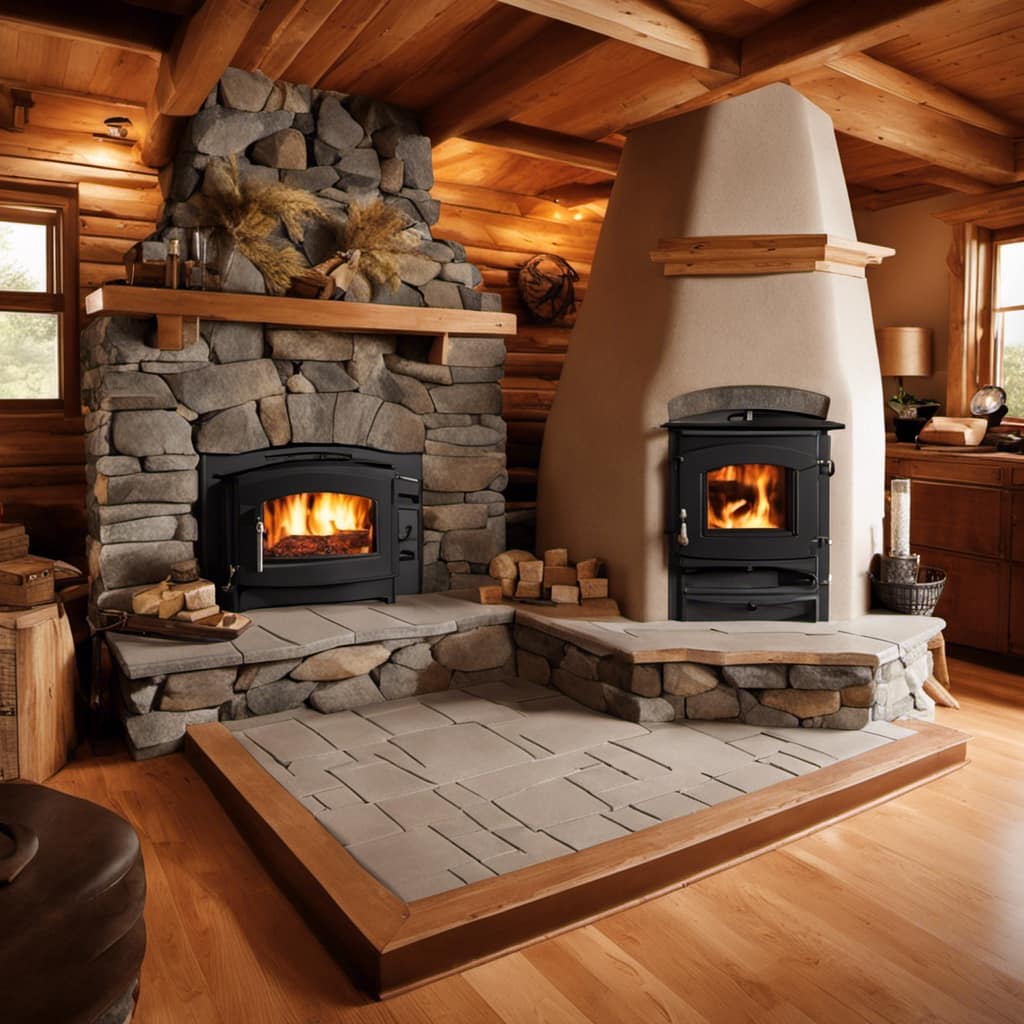

I’ve discovered the secret to keeping a wood stove burning all night. It’s not just about the type of firewood or the stove model used – it’s about the combination of multiple factors that lead to continuous, efficient burning.
In this article, I’ll share my knowledge and experience on properly seasoning firewood, maximizing airflow, and managing dampers and air controls. Follow these tips and you’ll never wake up to a cold stove again.
Key Takeaways
- Properly season firewood to ensure efficient and long-lasting burning.
- Control airflow by adjusting the damper and using air vents effectively.
- Use high-quality insulation materials and sealing techniques to prevent heat loss.
- Regularly clean and maintain the wood stove for optimal performance and safety.
Properly Seasoned Firewood
I make sure to use properly seasoned firewood to keep my wood stove burning all night. Properly seasoned firewood is essential for efficient and long-lasting burning. The key is to ensure that the firewood has a low moisture content.
Moisture content refers to the amount of water present in the wood. Green or freshly cut wood typically has a high moisture content, which can hinder combustion and create excessive smoke.
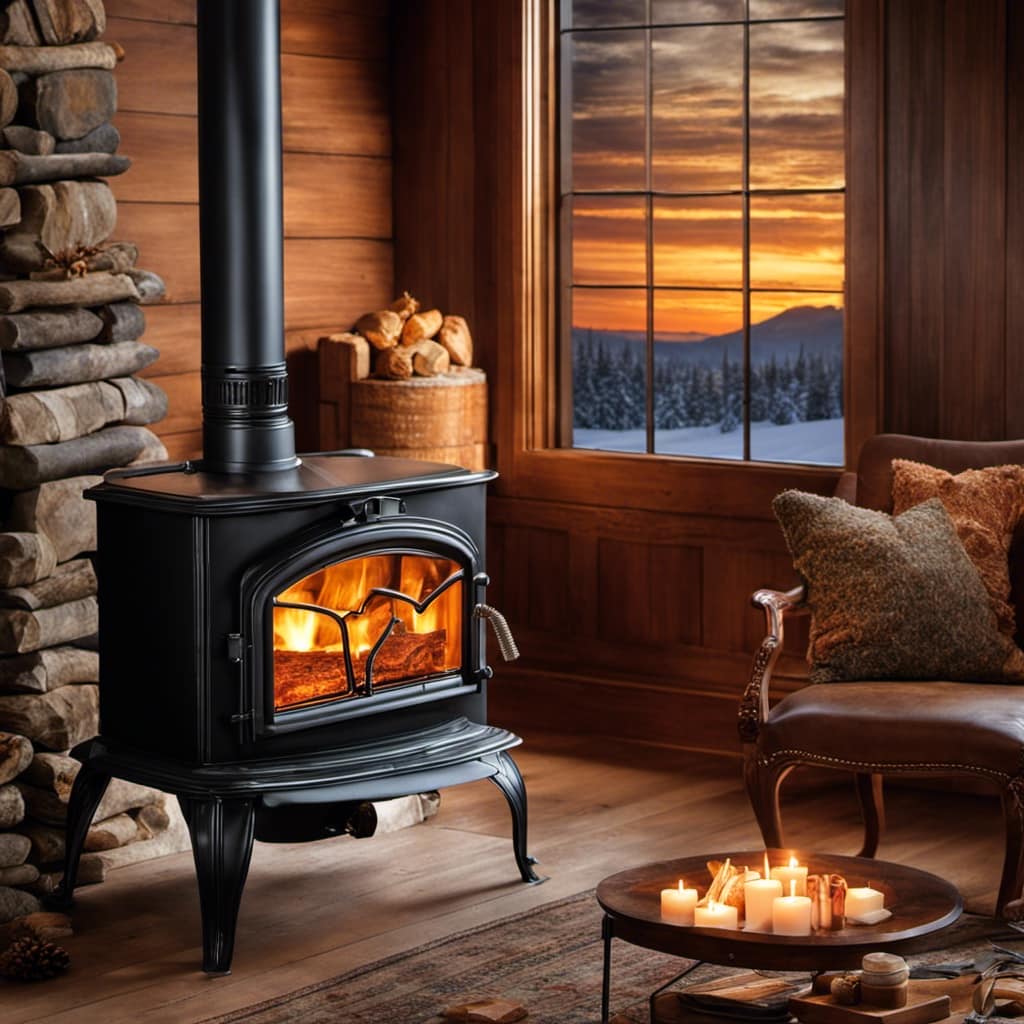
To properly season firewood, it should be stored in a dry and well-ventilated area for at least six months to a year. This allows the wood to dry out and reach a moisture content of around 20%. I store my firewood in a covered woodshed, elevated off the ground to prevent moisture absorption from the soil. It’s important to stack the firewood loosely, allowing air circulation between the logs. This promotes faster drying and reduces the risk of mold or rot.
Building a Long-Lasting Fire
Building a long-lasting fire requires careful attention to detail and proper technique. First, selecting the right type of wood is crucial, as dry hardwoods like oak and hickory burn longer and produce more heat.
Second, controlling the airflow is essential to maintaining a steady and consistent burn. Adjusting the damper and using the air vents effectively will help regulate the temperature and prevent the fire from burning too quickly.
Lastly, ensuring proper insulation and sealing around the fireplace or wood stove will minimize heat loss and maximize the efficiency of the fire, allowing it to burn for an extended period of time.
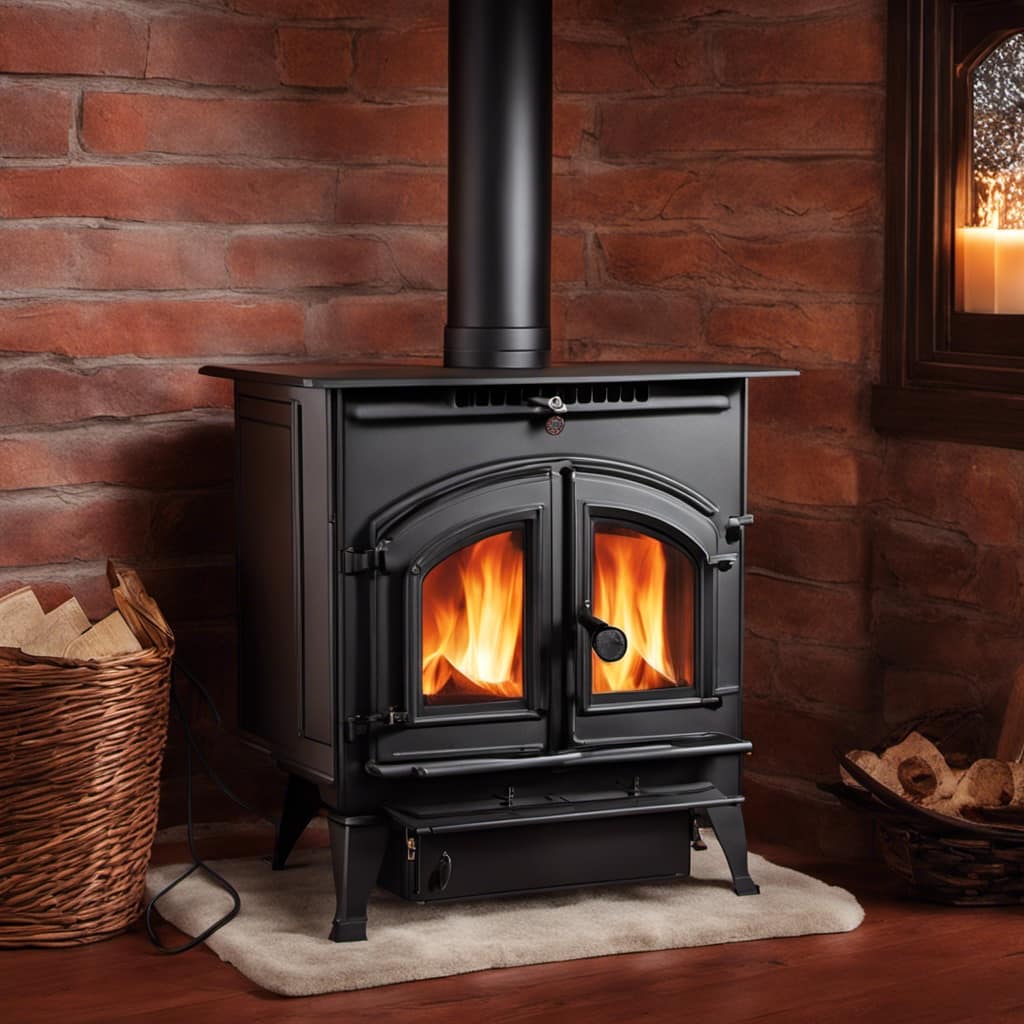
Proper Wood Selection
To keep a wood stove burning all night, it’s important to choose the right type of wood. The wood you select should be properly seasoned and have a low moisture content. Wet or green wood won’t burn efficiently and can cause excessive smoke and creosote buildup in the stove.
Here are some key factors to consider when selecting firewood:
-
Wood storage: Properly store your firewood in a dry and well-ventilated area. This will help reduce moisture content and ensure the wood burns efficiently.
-
Firewood moisture: Aim for a moisture content of around 20% or less. You can use a moisture meter to check the moisture level of the wood before burning.
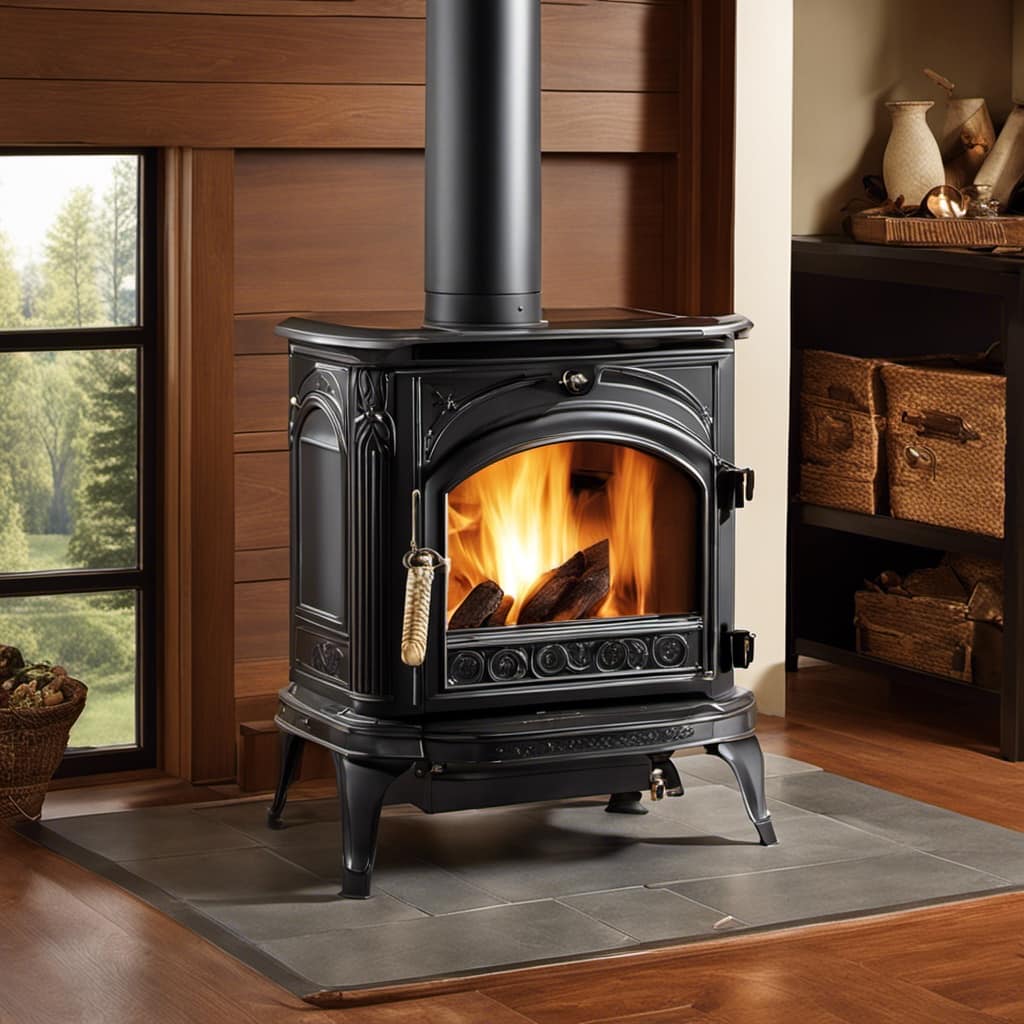
-
Hardwood vs. softwood: Hardwoods like oak and maple burn longer and produce more heat compared to softwoods like pine and spruce.
-
Wood size: Cut the firewood into small to medium-sized pieces for better airflow and more even burning.
By choosing the right type of wood and properly storing it, you can optimize the burning efficiency of your wood stove.
Now, let’s explore some airflow control techniques to further enhance the performance of your stove.

Airflow Control Techniques
Using the airflow control techniques, I can easily adjust the amount of oxygen entering the wood stove to regulate the burn rate and maintain optimal heat output. By manipulating the air vents, I can increase or decrease the airflow, which directly affects the combustion process.
To achieve a longer burn time, I typically close the primary air intake slightly to restrict the oxygen supply. This slows down the burn rate and extends the duration of the fire. However, it’s important to find the right balance because too little air can lead to incomplete combustion and excess smoke.
Regular stove maintenance is crucial to ensure proper airflow adjustments. This includes cleaning the air vents and removing any obstructions that may hinder the airflow. With these techniques, I can maximize the burn time of my wood stove and enjoy a cozy, warm atmosphere throughout the night.
Insulation and Sealing
With proper insulation and sealing, I can ensure that the heat produced by my wood stove stays inside and keeps my home warm throughout the night. Insulating and sealing techniques are crucial for maximizing the efficiency of a wood stove and preventing heat loss.
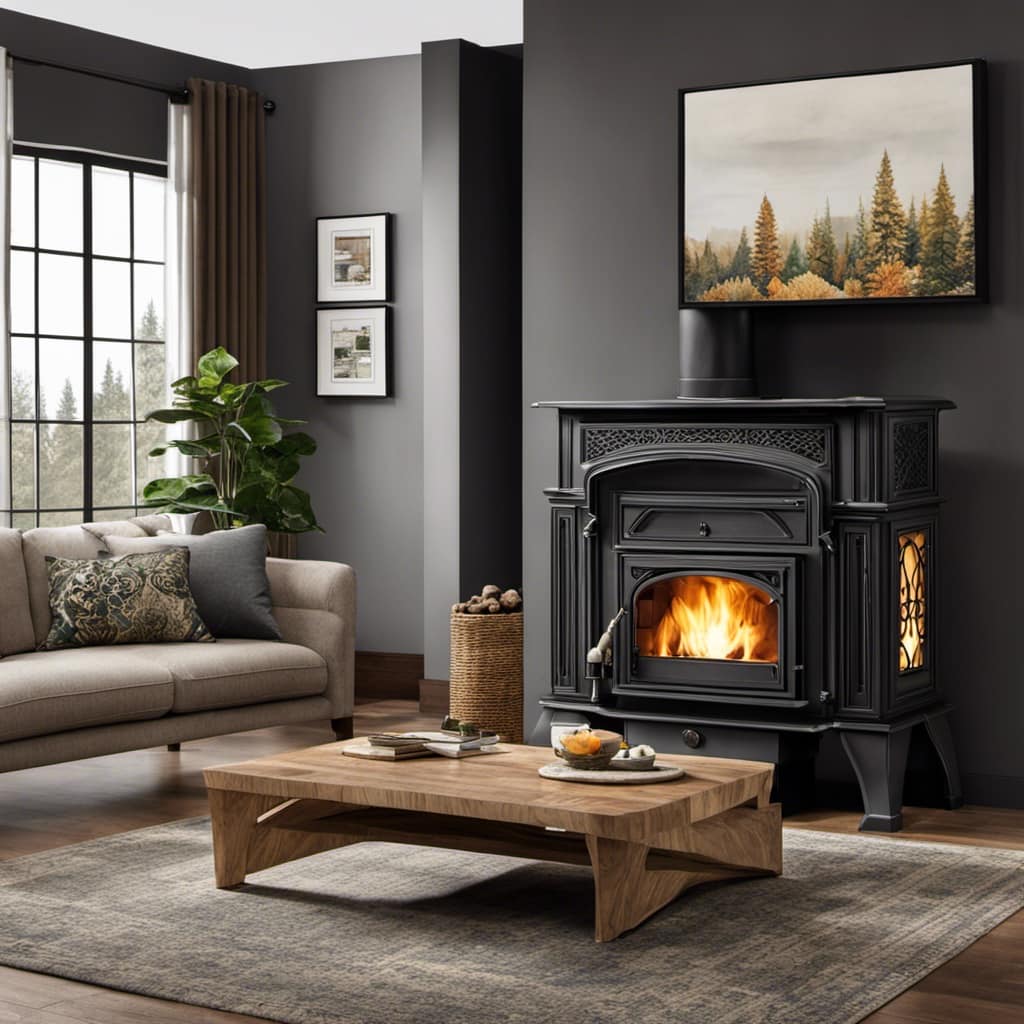
Here are four key methods to consider:
-
Use high-quality insulation materials such as mineral wool or fiberglass to wrap around the chimney and stove pipes. This prevents heat from escaping through the walls and directs it into the living space.
-
Seal any gaps or cracks around windows, doors, and vents using weatherstripping or caulking. This prevents cold air from entering and warm air from escaping.
-
Install a heat-resistant glass door on the wood stove. This not only adds a layer of insulation but also allows you to monitor the fire and adjust airflow without opening the stove door.
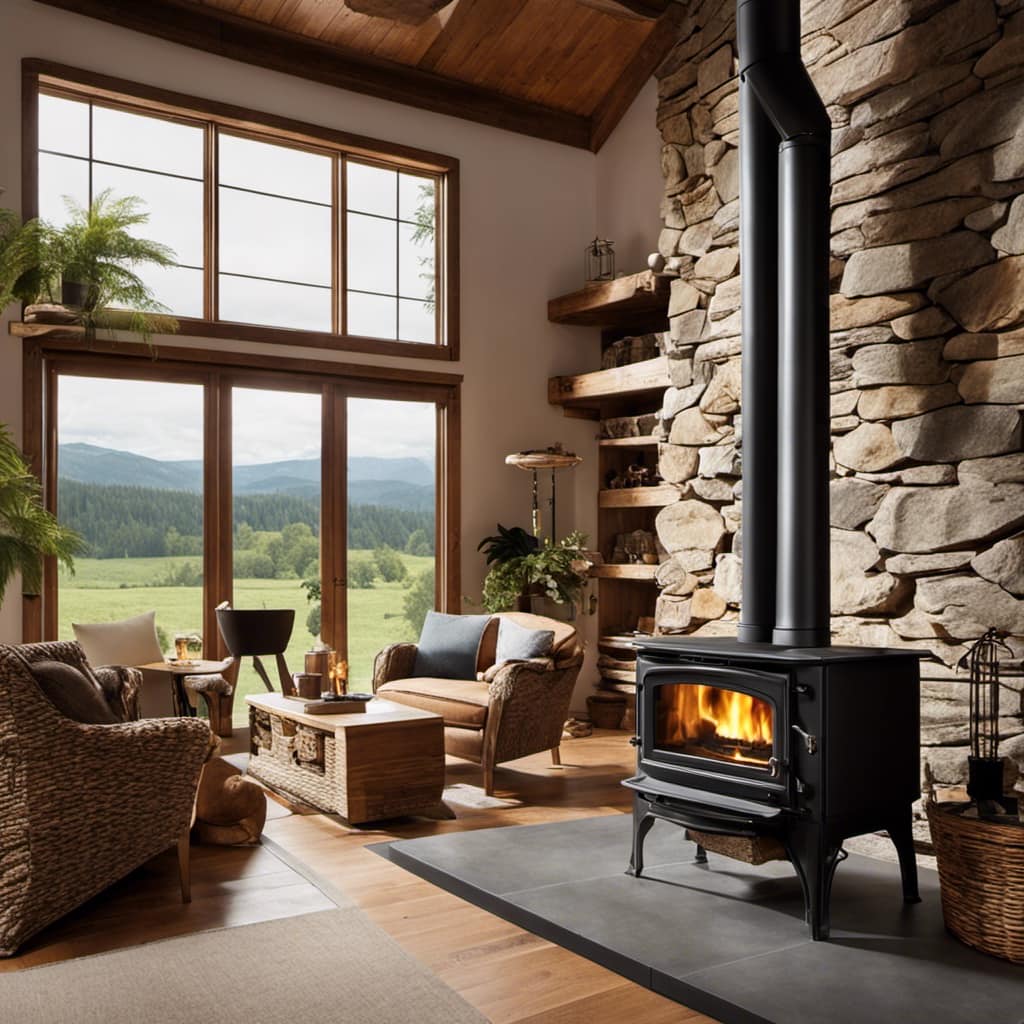
-
Consider insulating the floor and ceiling in the area where the wood stove is located. This helps retain heat within the room and prevents it from escaping to other parts of the house.
Using the Right Wood Stove
I find that the right wood stove makes a big difference in keeping the fire burning all night. When it comes to building a fire, the efficiency of the wood stove plays a crucial role. A well-designed wood stove ensures that the fire burns steadily and efficiently, allowing for longer burn times without constant refueling.
To achieve optimal wood stove efficiency, it’s essential to consider a few key factors. First, the size of the stove should match the space it will be heating. A stove that’s too small may struggle to generate enough heat, while a stove that’s too large can lead to inefficient burning and wasted energy.
Additionally, the design of the wood stove can greatly impact its efficiency. Look for stoves with features like secondary combustion, which allows for more complete burning of the wood and reduces the amount of smoke and pollutants released into the air.

Furthermore, efficient air control is crucial for maintaining a long-lasting fire. Stoves equipped with adjustable air vents or dampers allow you to regulate the airflow, helping to control the burn rate and maximize heat output. By adjusting the air intake, you can achieve a steady burn throughout the night.
In conclusion, choosing the right wood stove is essential for maintaining a long-lasting fire. By considering factors such as size, design, and air control, you can ensure optimal wood stove efficiency and enjoy a comfortably warm space throughout the night.
Now, let’s explore the next step in maximizing airflow for efficient burning.
Maximizing Airflow for Efficient Burning
When it comes to maximizing airflow for efficient burning in a wood stove, there are a few heating efficiency tips that can help prevent smoke buildup. Here are four key strategies to consider:
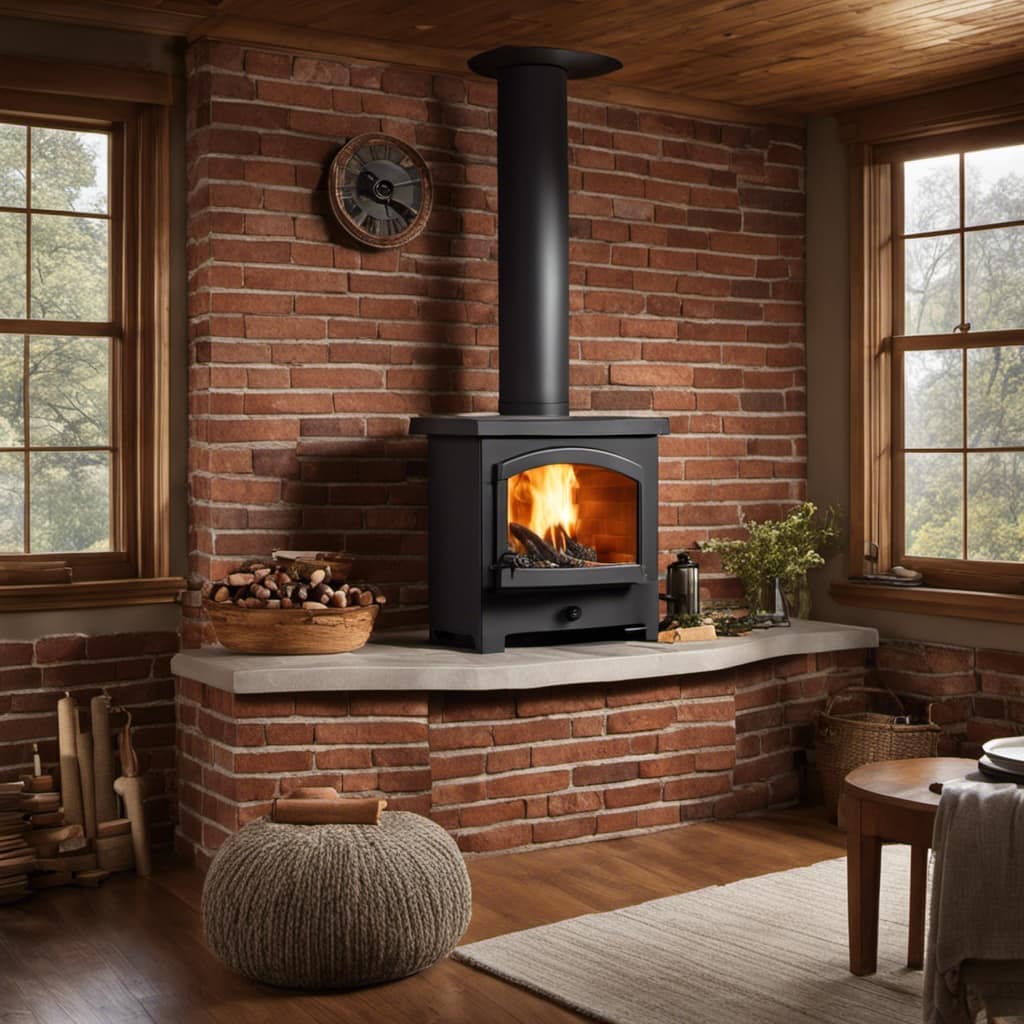
-
Properly load the wood stove: Make sure to arrange the firewood in a way that allows for good airflow. Start with smaller pieces at the bottom and gradually increase the size as you build the fire. This will ensure a steady and efficient burn.
-
Use the air vents effectively: Most wood stoves have air vents that control the amount of oxygen entering the firebox. Adjusting these vents can help regulate the burn rate and prevent smoke buildup. Open the vents fully when starting the fire and gradually close them as the fire becomes established.
-
Keep the stove clean: Regularly remove ash and debris from the firebox and clean the flue to ensure optimal airflow. A clean stove will allow for better combustion and reduce the risk of smoke buildup.
-
Use seasoned firewood: Seasoned firewood has a lower moisture content, which means it burns more efficiently and produces less smoke. Avoid burning green or wet wood, as it can lead to incomplete combustion and increased smoke production.
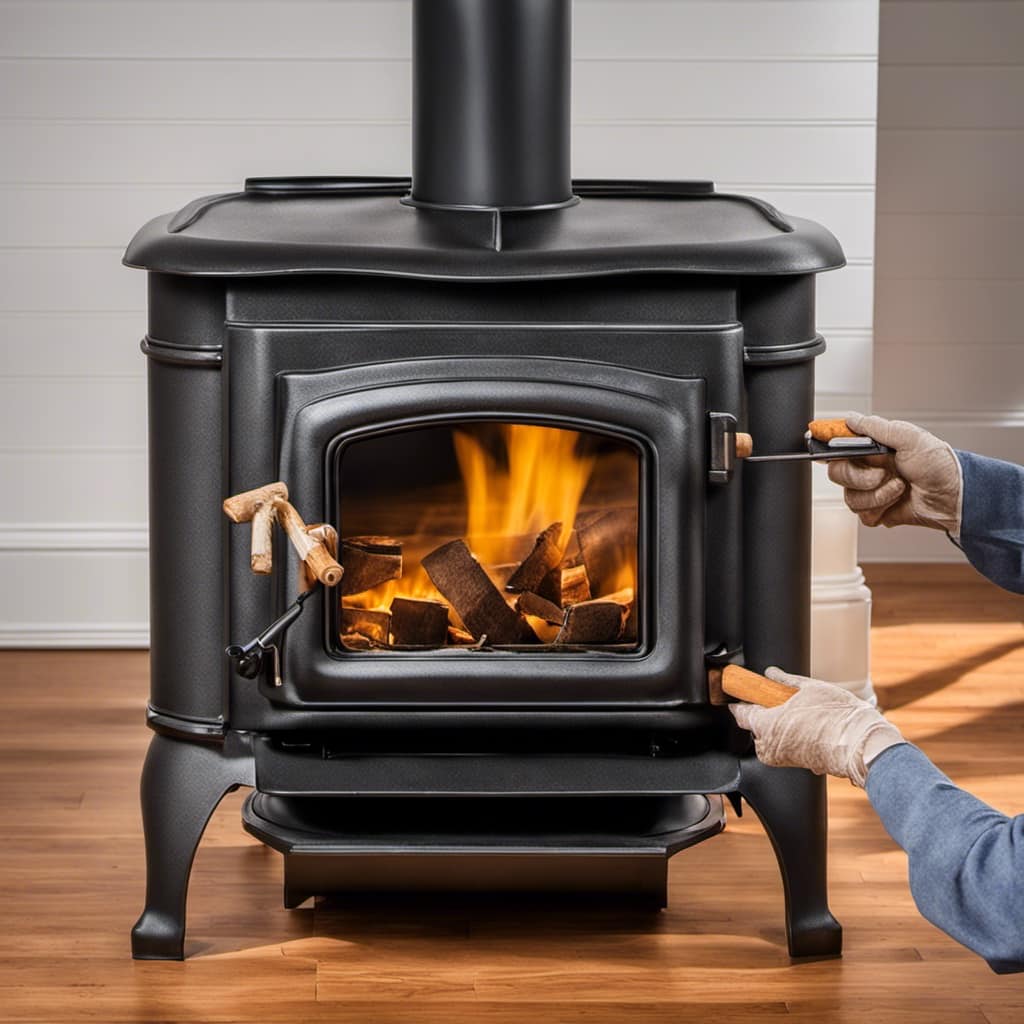
Managing Dampers and Air Controls
To ensure efficient burning in my wood stove, I adjust the dampers and air controls accordingly to regulate the flow of oxygen and prevent smoke buildup. Managing draft and minimizing heat loss are crucial in maintaining a steady and long-lasting fire. When it comes to dampers, there are typically two types: primary and secondary. The primary damper, located at the base of the stove, controls the amount of air entering the firebox. By opening it fully, I allow more oxygen to reach the fire, increasing its intensity. However, if I want to slow down the burn rate, I can partially close the primary damper to restrict the airflow. The secondary damper, found near the flue or chimney, helps control the draft. By adjusting this damper, I can regulate how much heat is lost up the chimney. By minimizing the heat loss, I can ensure that more heat is radiated into the room, making the wood stove more efficient.
| Dampers | Function | Adjustment |
|---|---|---|
| Primary | Controls airflow | Open fully for intense fire, partially close to slow burn rate |
| Secondary | Regulates draft | Adjust to minimize heat loss up the chimney |
Maintaining a Consistent Temperature
Maintaining a consistent temperature is crucial for optimal performance and efficiency of any heating system. To achieve this, it’s important to consider the fuel type used, as different fuels burn at different rates and produce varying amounts of heat.
Additionally, controlling the airflow is essential in regulating the combustion process and ensuring a steady temperature.
Lastly, proper insulation plays a vital role in heat retention, preventing energy loss and maintaining a consistent temperature throughout the space.
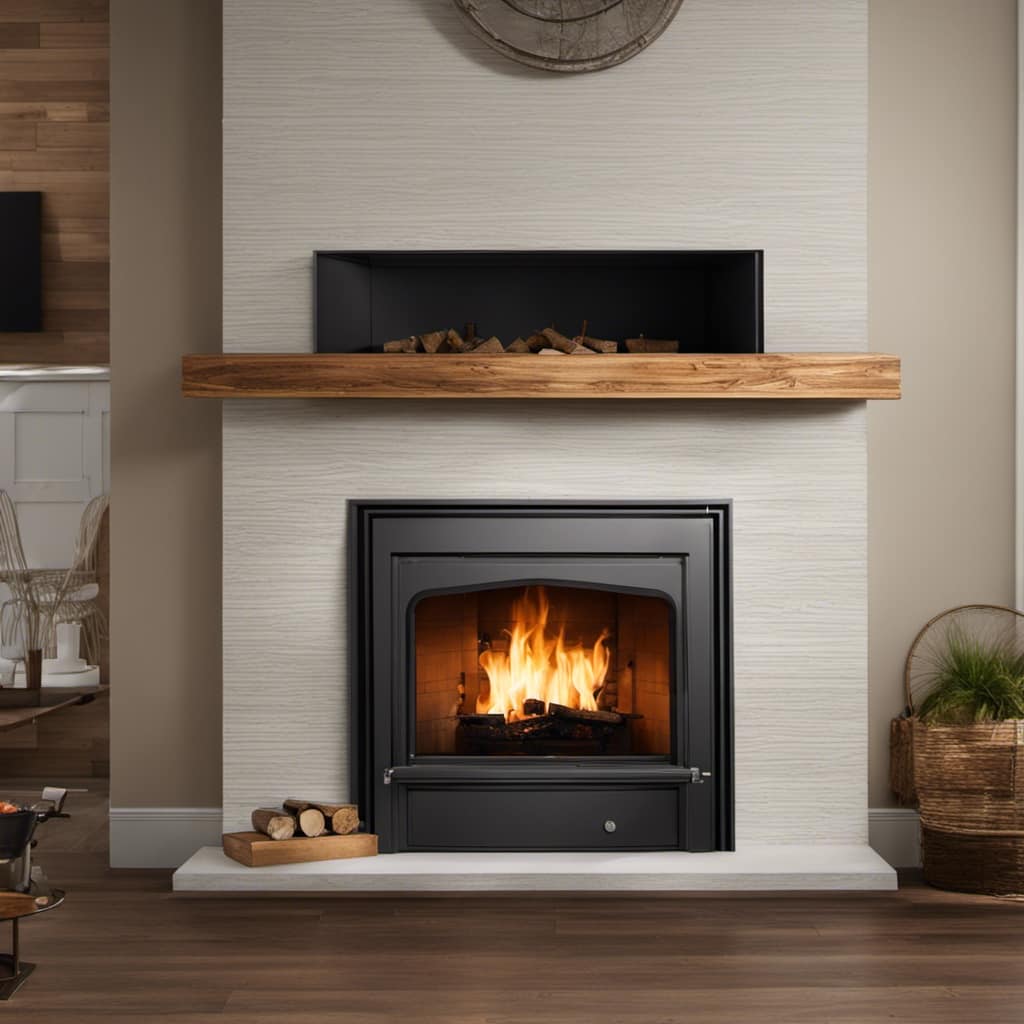
Fuel Type for Longevity
I find that using hardwoods like oak or maple provides longer burn times for my wood stove. Hardwoods are denser and have a higher energy content compared to softwoods like pine or fir. This means that they burn slower and release more heat, resulting in improved fuel efficiency.
However, there are alternative options that can also provide extended burn times:
-
Pellets: Made from compressed sawdust, pellets are highly efficient and produce minimal ash. They’re designed to burn cleanly and evenly, ensuring a consistent heat output throughout the night.
-
Coal: Although not commonly used, coal is a dense and slow-burning fuel option. It can generate a substantial amount of heat and maintain a fire for an extended period.
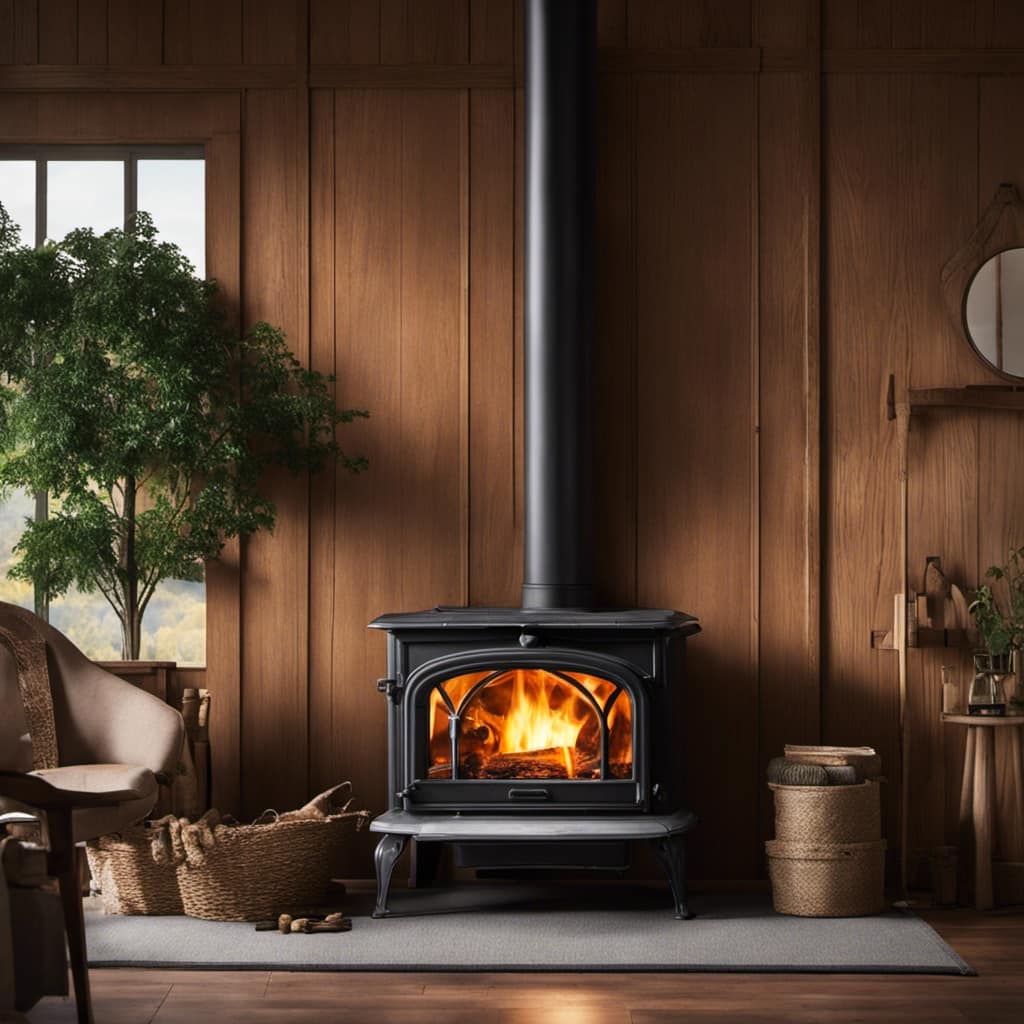
-
Dried fruit tree wood: This type of wood, like apple or cherry, is known for its high energy content. It burns slower than softwoods and can provide a longer-lasting fire.
-
Bricks or heat logs: These compressed fuel sources are specifically designed for long burn times. They’re made from a mixture of wood by-products and additives, resulting in a slow and sustained burn.
Airflow Control Techniques
When adjusting the damper and opening the stove door slightly, I can control the airflow to ensure a steady and efficient burn. The damper adjustment is a crucial step in regulating the intake of oxygen into the wood stove. By increasing the damper opening, more air is allowed in, resulting in a hotter, more intense fire.
Conversely, reducing the damper opening restricts the airflow, leading to a slower burn and less heat output. Flue pipe maintenance also plays a vital role in airflow control. Regular cleaning of the flue pipe prevents the buildup of creosote, a highly flammable substance that can obstruct the airflow.
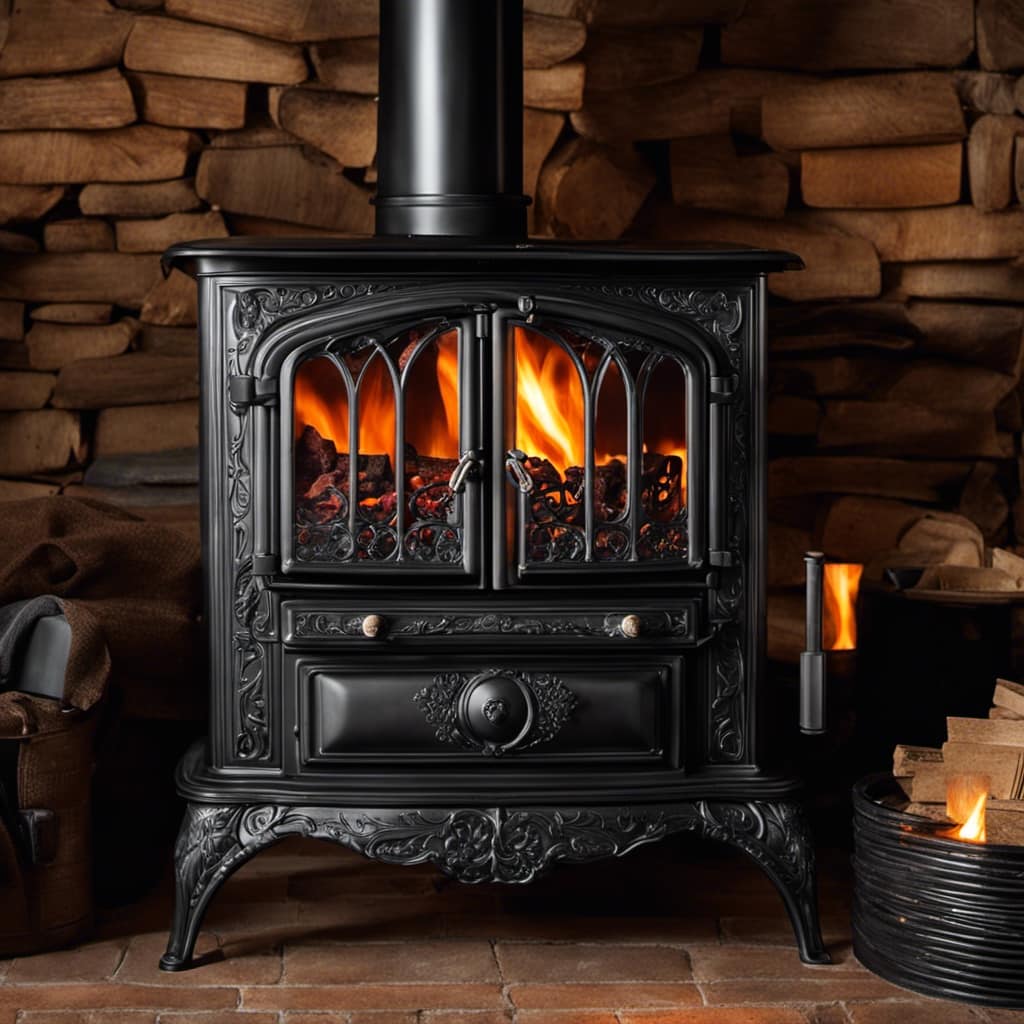
Clearing any blockages or debris from the flue pipe ensures a smooth and efficient passage of exhaust gases, promoting better combustion and a longer-lasting fire.
Insulation for Heat Retention
When it comes to keeping a wood stove burning all night, insulation plays a crucial role in heat retention.
Insulating your stove and the surrounding area can help prevent heat loss and maintain a comfortable temperature throughout the night. Heat resistant materials are essential for insulation, as they can withstand the high temperatures generated by the wood stove.
Additionally, an energy efficient design is important to maximize heat retention and minimize energy waste.
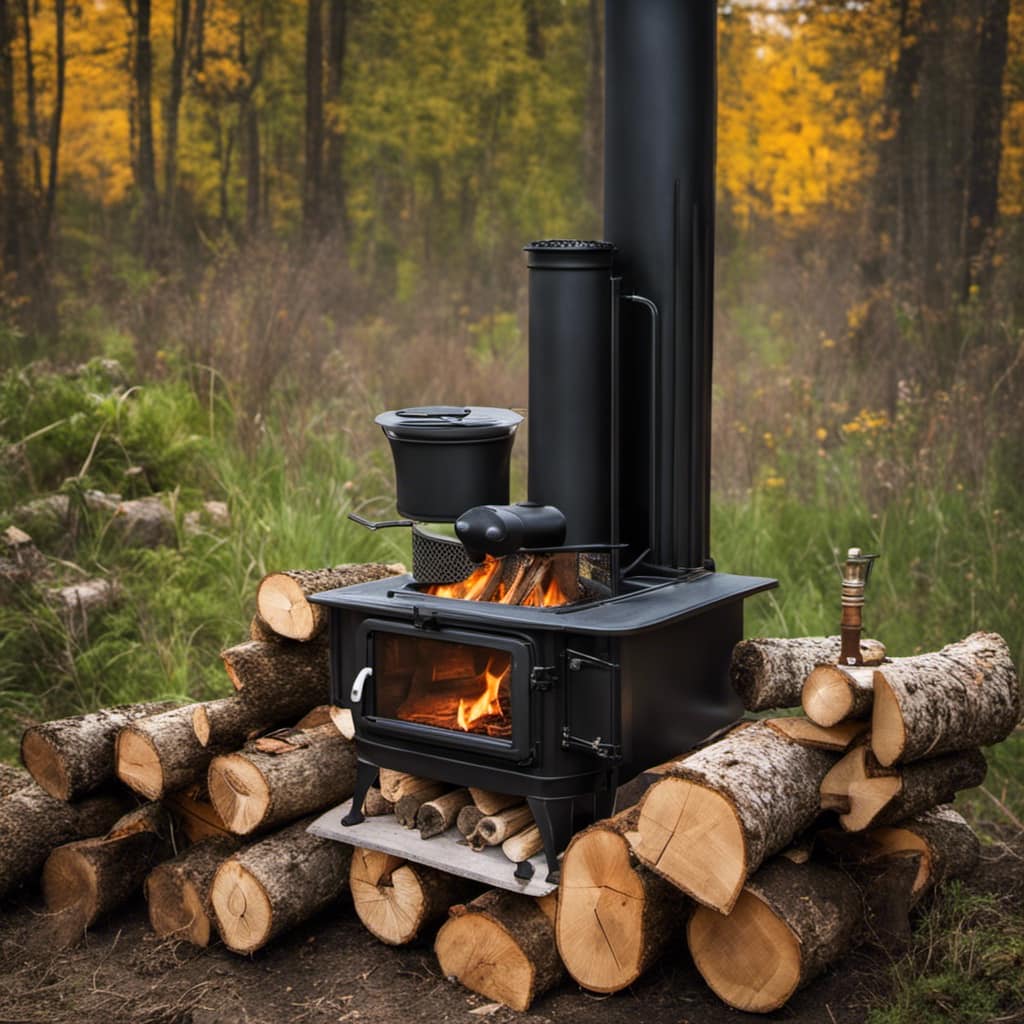
Here are four key factors to consider when insulating for heat retention:
- Using heat resistant materials such as fire bricks or ceramic fiber insulation
- Ensuring proper sealing around the stove and chimney to prevent air leaks
- Adding insulation to the walls and ceiling of the room to retain heat
- Installing a heat reflective barrier behind the stove to reflect heat back into the room.
Adding Fuel Throughout the Night
To keep the wood stove burning all night, I’ve found that adding fuel periodically throughout the night helps maintain a consistent heat. This technique maximizes burn time and ensures fuel efficiency. By adding fuel at regular intervals, you can keep the fire going without having to wake up in the middle of the night to tend to it.
To illustrate the importance of adding fuel throughout the night, I have created a table below that showcases the burn time and fuel efficiency of different wood types:
| Wood Type | Burn Time (hours) | Fuel Efficiency |
|---|---|---|
| Oak | 6-8 | High |
| Maple | 4-6 | Medium |
| Pine | 2-4 | Low |
| Birch | 3-5 | Medium |
| Ash | 5-7 | High |
As you can see, different wood types have varying burn times and fuel efficiencies. It is essential to choose the right type of wood for your wood stove to ensure a longer burn time and maximize fuel efficiency. By adding fuel throughout the night, you can extend the burn time and maintain a steady heat output, keeping your home warm and cozy all night long.
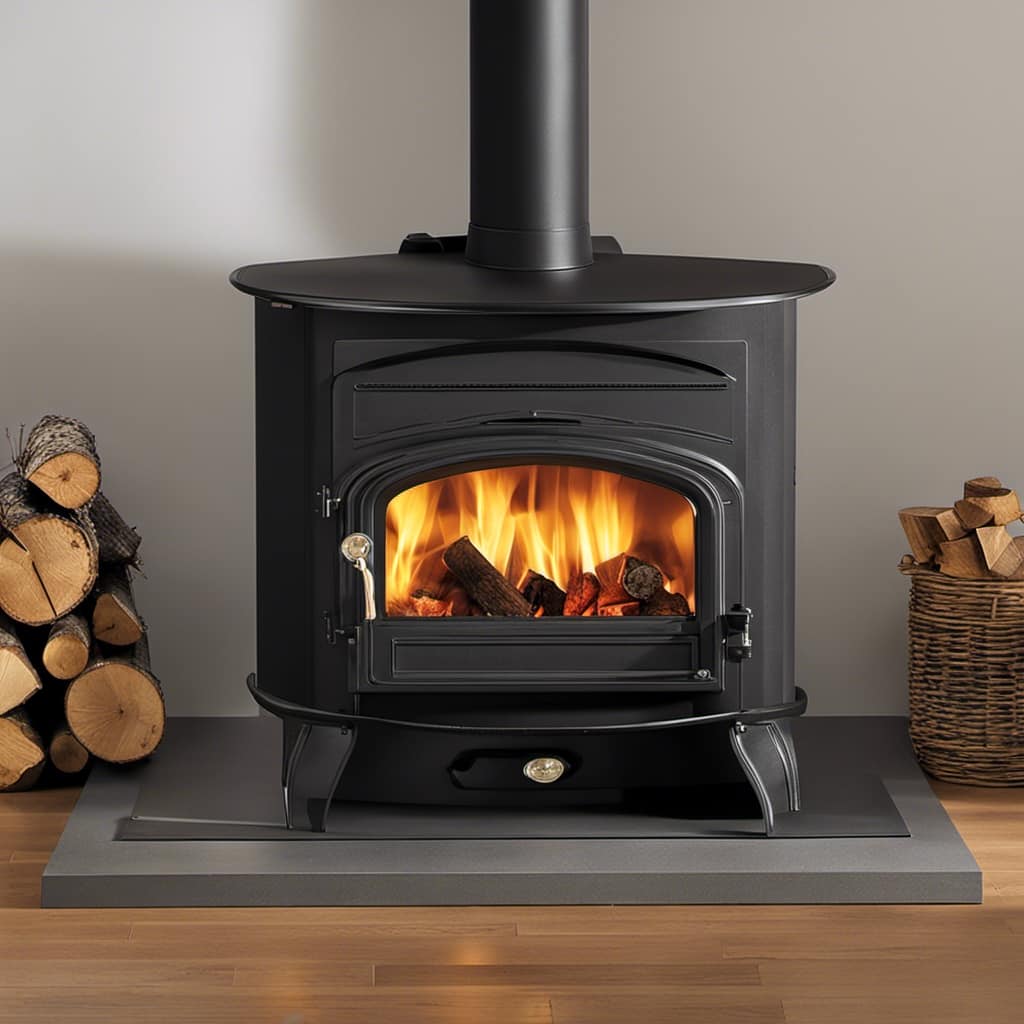
Cleaning and Inspecting the Wood Stove
Inspecting and cleaning the wood stove regularly ensures its optimal performance and reduces the risk of potential hazards. Proper maintenance is essential for keeping your wood stove in good working condition. Here are some cleaning techniques and safety measures to consider:
-
Remove ashes: Before cleaning the stove, make sure it has cooled down completely. Use a metal scoop or shovel to remove the ashes from the firebox. Dispose of the ashes in a metal container with a tight-fitting lid, and store it away from flammable materials.
-
Clean the glass: Over time, the glass on the stove door can become dirty and obstruct your view of the fire. Use a glass cleaner specifically designed for wood stoves to remove soot and grime. Avoid using abrasive materials that could scratch the glass.
-
Check for creosote buildup: Creosote is a highly flammable substance that can accumulate in the chimney and stovepipe. Inspect these areas regularly and remove any creosote buildup using a chimney brush. This will help prevent chimney fires.
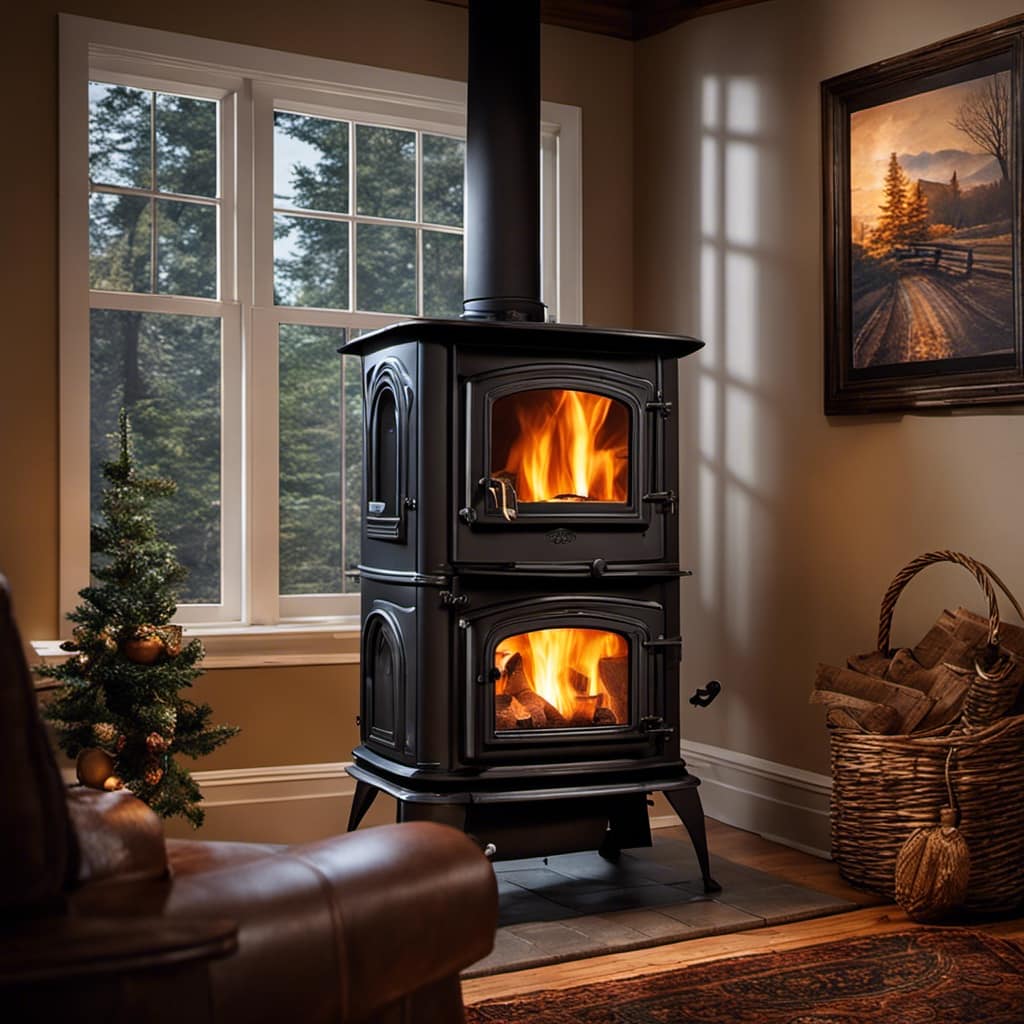
-
Inspect the gaskets: The gaskets on the stove door and ash pan should be in good condition to ensure a proper seal. Replace any worn or damaged gaskets to prevent air leaks.
Regular cleaning and inspection of your wood stove will help maintain its efficiency and reduce the risk of fire hazards.
Now, let’s move on to discussing safety precautions for overnight burning.
Safety Precautions for Overnight Burning
Now that we’ve discussed how to clean and inspect the wood stove, let’s move on to the important topic of safety precautions for overnight burning. Ensuring fire safety is crucial when operating a wood stove, especially when leaving it unattended for an extended period.

One major concern is the risk of carbon monoxide poisoning. To prevent carbon monoxide buildup, it’s essential to have a working carbon monoxide detector installed near the wood stove. This device will alert you if dangerous levels of carbon monoxide are detected in the air. Additionally, make sure the wood stove is properly ventilated to allow for the safe release of combustion gases.
When leaving the stove burning overnight, it’s crucial to use the right type of fuel. Only burn seasoned hardwoods that have been properly dried for at least six months. These woods produce less creosote buildup and burn more efficiently, reducing the risk of chimney fires.
Furthermore, it’s essential to maintain a clear area around the wood stove. Keep flammable materials, such as furniture, curtains, and rugs, at a safe distance. Install a fireproof hearth rug to prevent sparks from reaching the floor.
Frequently Asked Questions
Can I Use Any Type of Wood in My Wood Stove?
Yes, you can use different types of wood in your wood stove. The type of wood you choose will affect the burn time and heat output. Hardwoods like oak and maple burn slower and produce more heat, making them ideal for overnight burning.
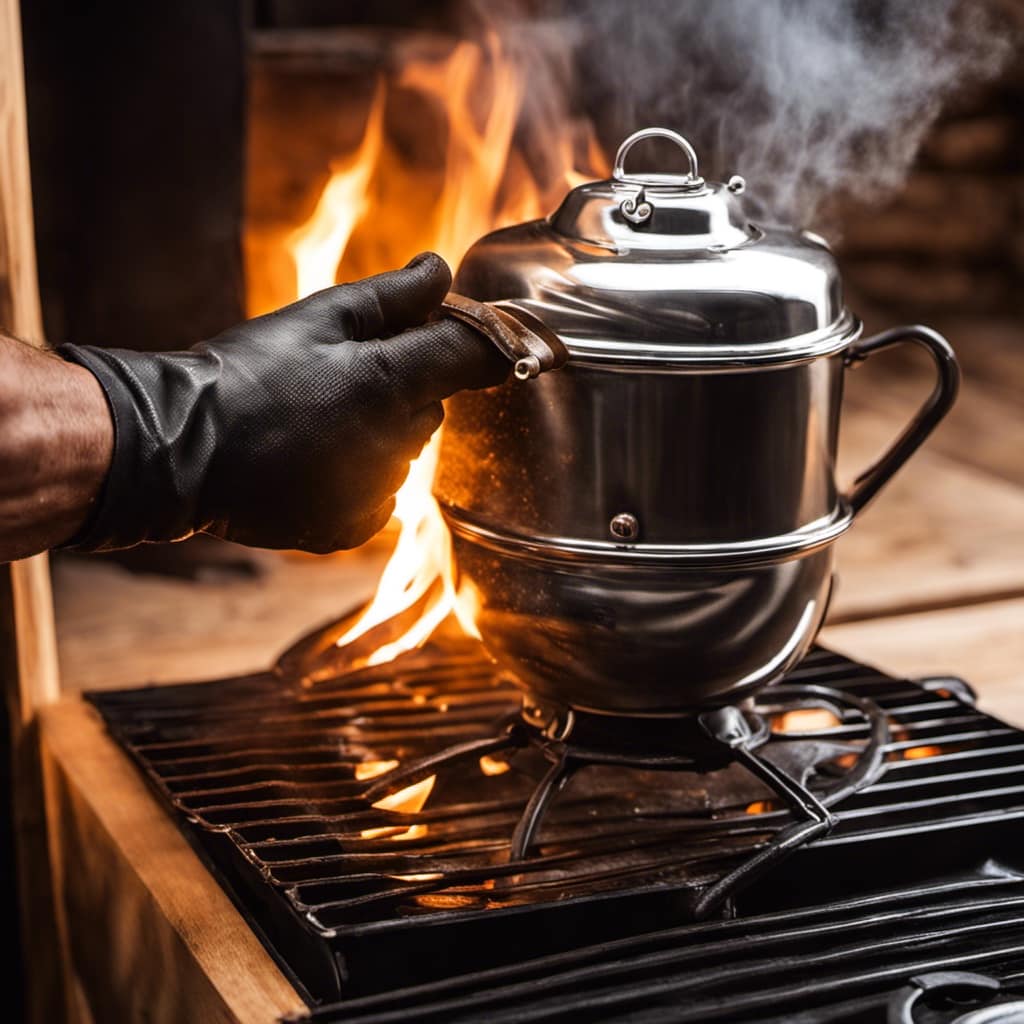
Softwoods like pine and fir burn faster and produce less heat, making them better for quick bursts of warmth. Remember to properly season and store your wood for optimal burning efficiency.
As for starting a fire, there are various methods, such as using kindling, newspaper, or fire starters.
How Often Should I Clean My Wood Stove?
Cleaning my wood stove is a crucial task that I can’t afford to neglect. Regular cleaning ensures optimal performance and prevents dangerous buildup of creosote. It’s recommended to clean the stove at least once a month during the burning season.
Neglecting this task can lead to decreased efficiency, increased risk of chimney fires, and even carbon monoxide poisoning. So, remember to take the time to properly maintain your wood stove for a safe and enjoyable fire experience.
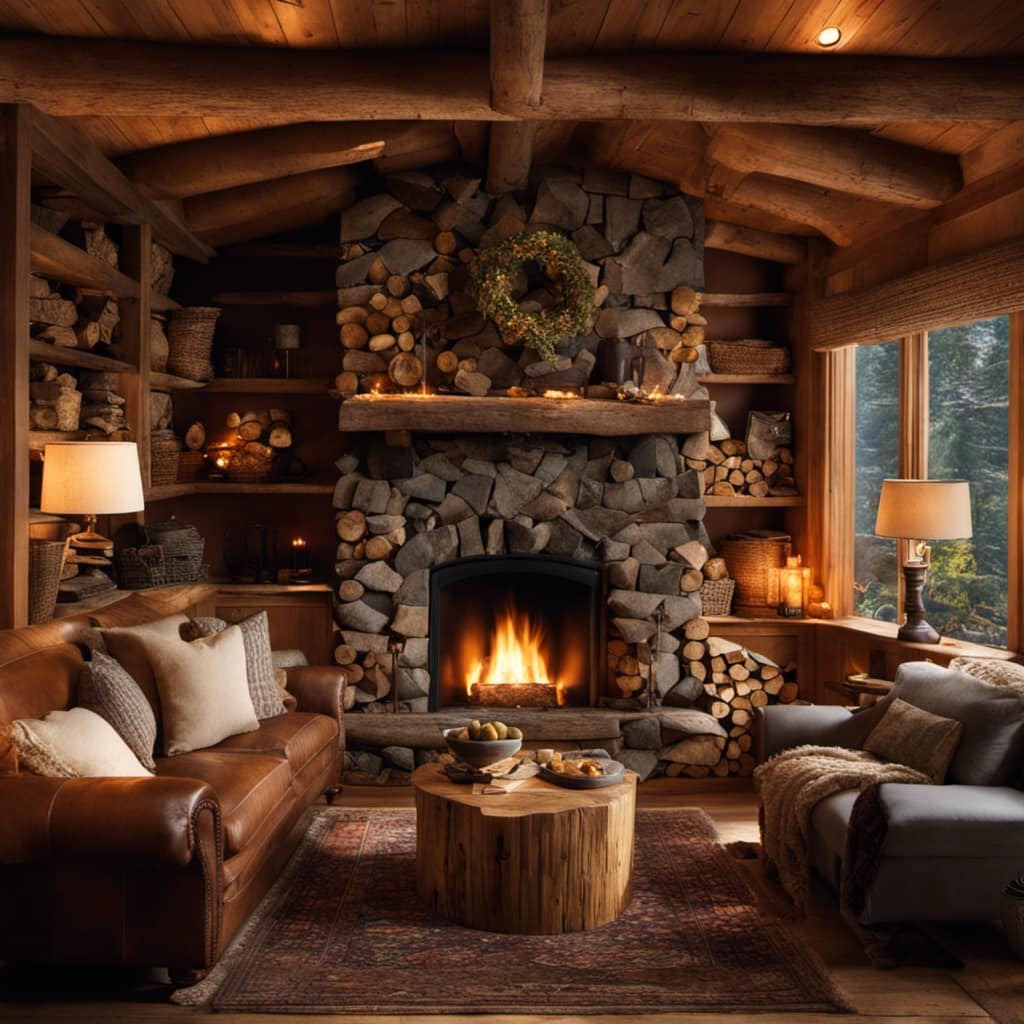
Is It Safe to Leave a Wood Stove Burning Overnight?
Leaving a wood stove burning overnight can be risky if proper safety precautions aren’t taken.
It’s important to ensure that the stove is in good condition and that there are no flammable materials nearby.
Additionally, using alternatives to leaving the stove burning all night, such as using fire bricks or installing a stove fan, can help maintain a consistent and safe heat source while reducing the risk of accidents.
Can I Use Newspaper or Cardboard to Start a Fire in My Wood Stove?
Yes, I can use newspaper or cardboard to start a fire in my wood stove. It’s a convenient and readily available alternative to traditional fire starters.
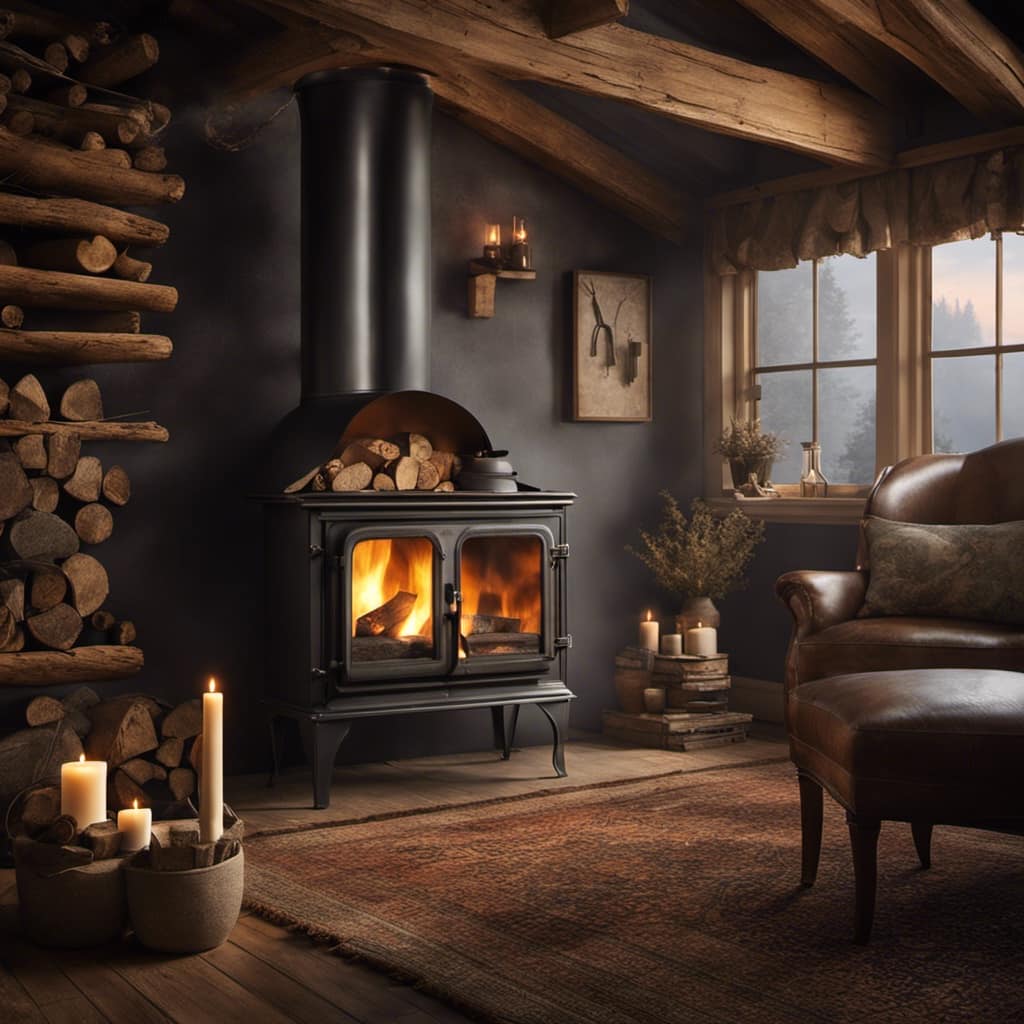
However, it’s important to ensure that the newspaper or cardboard is dry and free from any ink or chemicals that may produce harmful fumes.
Additionally, using the right type of wood, such as hardwoods like oak or maple, will help maintain a longer burn time and keep the wood stove burning all night.
What Should I Do if My Wood Stove Is Smoking Excessively?
When my wood stove is smoking excessively, I first check if the damper is open enough to allow proper airflow. If that’s not the issue, I inspect the chimney for any blockages or creosote buildup. Cleaning the chimney regularly can prevent excessive smoke.
Additionally, using properly seasoned firewood and avoiding damp or green wood can help. If the problem persists, consulting a professional chimney sweep or stove technician is recommended to troubleshoot and resolve the issue.
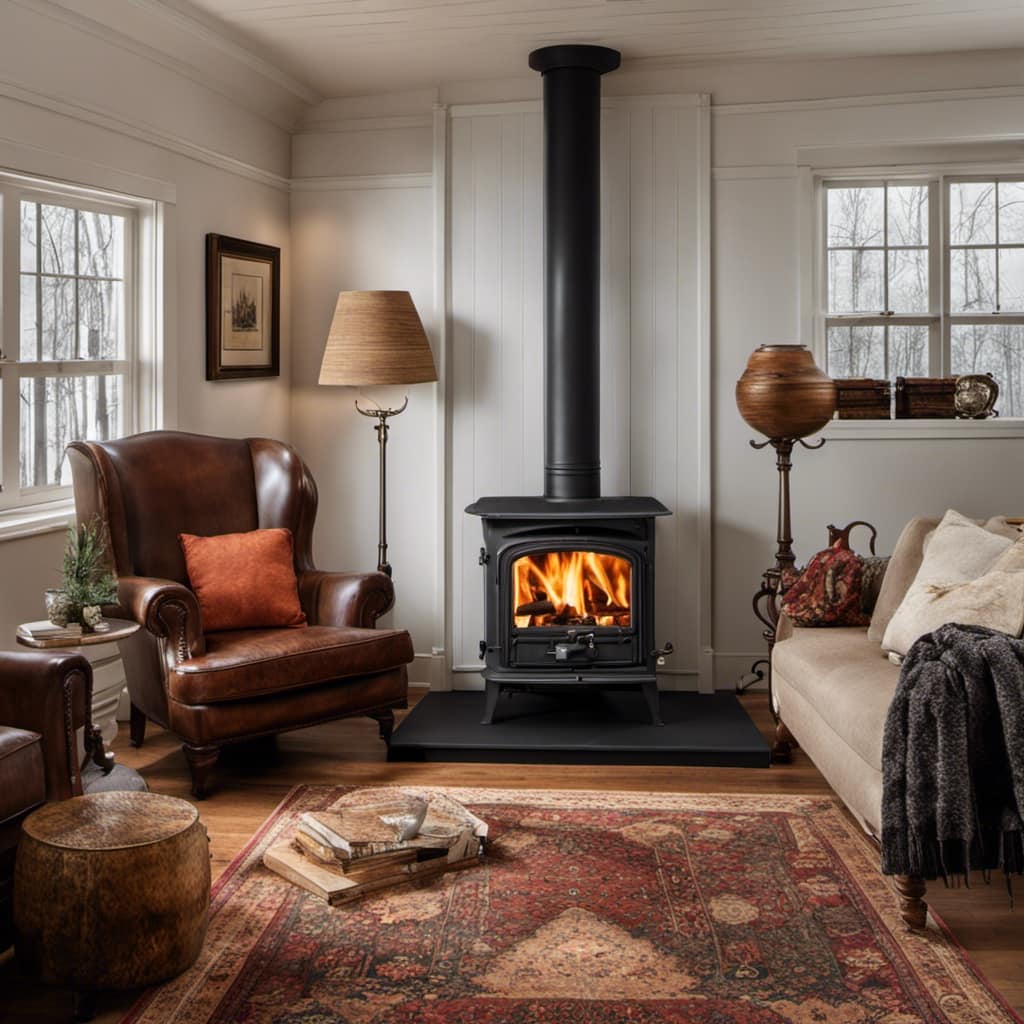
Conclusion
In conclusion, by following the proper steps and techniques, it’s possible to keep a wood stove burning all night.
From using properly seasoned firewood to maximizing airflow and managing dampers, these tips ensure efficient burning and a consistent temperature.
Regular cleaning and maintenance, along with practicing safety precautions, are also essential for overnight burning.
By implementing these strategies, you can enjoy a cozy and warm night’s sleep with your wood stove.
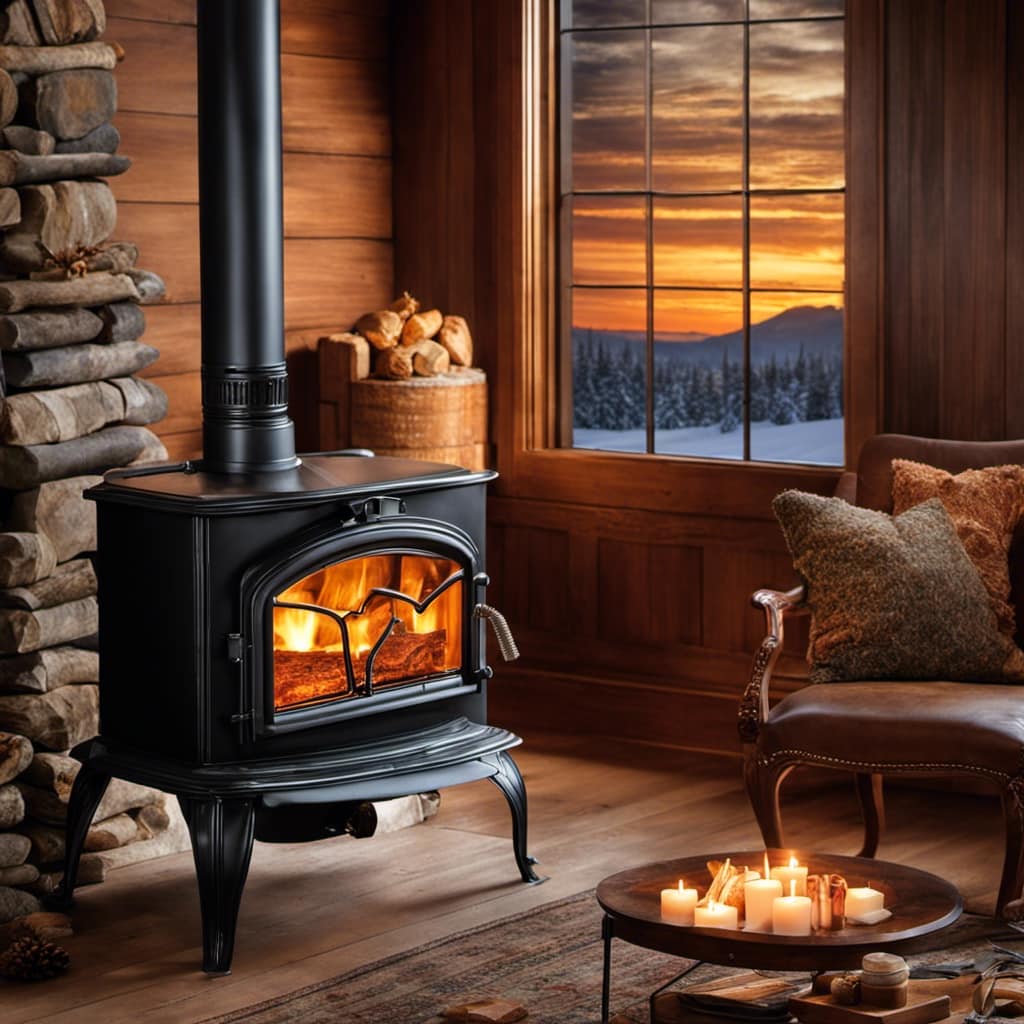
Growing up surrounded by the vast beauty of nature, Sierra was always drawn to the call of the wild. While others sought the comfort of the familiar, she ventured out, embracing the unpredictable and finding stories in the heartbeat of nature.
At the epicenter of every remarkable venture lies a dynamic team—a fusion of diverse talents, visions, and passions. The essence of Best Small Wood Stoves is crafted and refined by such a trio: Sierra, Logan, and Terra. Their collective expertise has transformed the platform into a leading authority on small wood stoves, radiating warmth and knowledge in equal measure.
Wood Stove
What Happens When Aluminum Is Put A Wood Stove
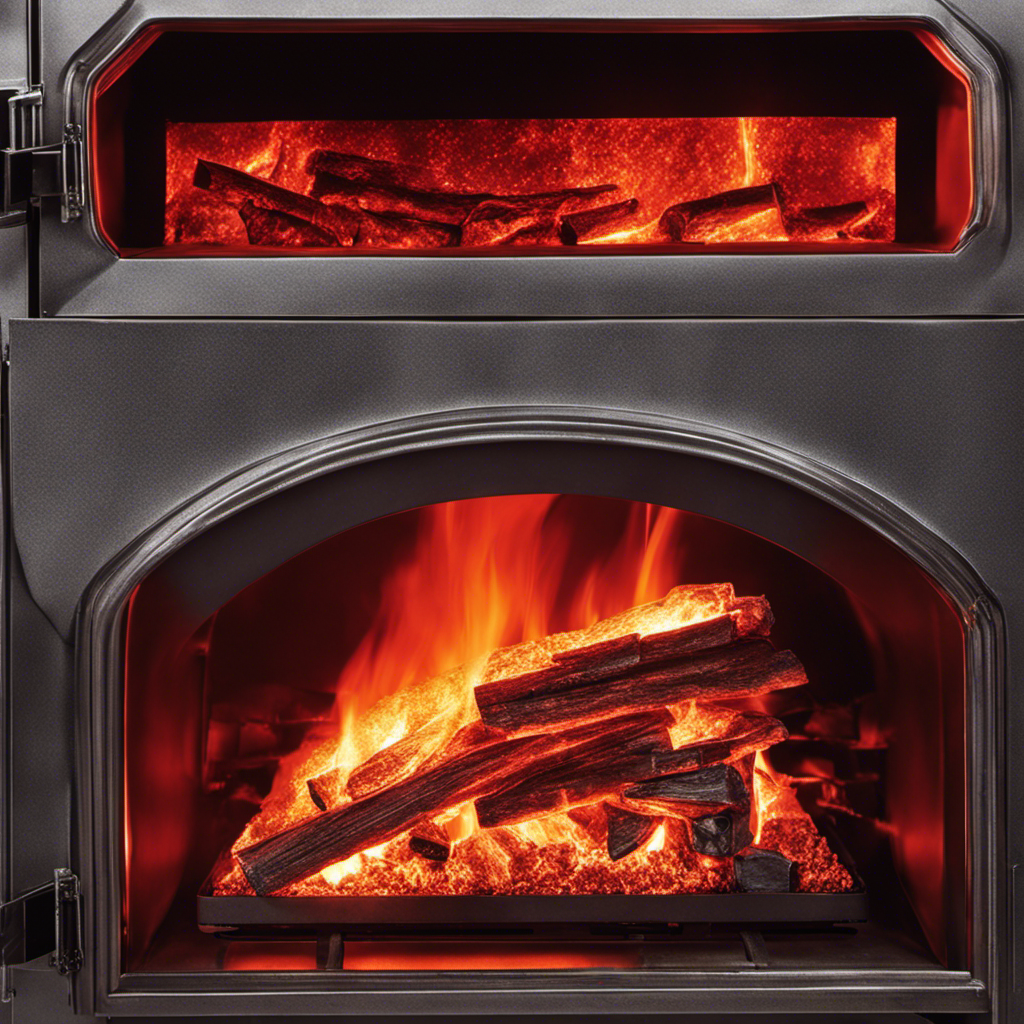
When I throw a thin aluminum strip into the powerful flames of my wood-burning stove, a captivating chemical reaction takes place right before my eyes. In this article, I will explore the scientific principles that can help us understand this mesmerizing phenomenon.
By exploring the thermal properties of aluminum, the combustion and oxidation processes, and the impact on the stove’s efficiency, we can uncover the intricate mechanisms at play.
However, we must also consider safety precautions when experimenting with this fiery interaction.
Let’s delve into the captivating world of aluminum and wood stove combustion.
Key Takeaways
- Aluminum undergoes oxidation when exposed to oxygen in the air, and the intense heat in a wood stove accelerates this process.
- The chemical reaction between aluminum and oxygen produces aluminum oxide, and the high temperature in the wood stove provides the energy for the reaction.
- Aluminum has high thermal conductivity and is commonly used in industries like automotive, aerospace, and electronics for efficient heat transfer.
- Using aluminum foil in a wood stove reflects heat back into the firebox, improves combustion, reduces energy consumption, helps distribute heat evenly, and can lower fuel consumption.
The Science Behind the Reaction
I can explain the science behind the reaction between aluminum and a wood stove.
When aluminum is put in a wood stove, a chemical reaction occurs due to the intense heat. Aluminum is a highly reactive metal, and when it comes into contact with oxygen in the air, it undergoes oxidation. The heat from the wood stove accelerates this process, causing the aluminum to react even more rapidly.
This chemical reaction produces aluminum oxide, which is a compound of aluminum and oxygen. The heat transfer in this reaction is significant, as the high temperature of the wood stove provides the energy needed for the reaction to take place.
Overall, the combination of the chemical reaction and heat transfer results in the aluminum undergoing a transformation in the wood stove.
Thermal Properties of Aluminum
Although aluminum is a metal, it has impressive thermal conductivity properties that make it an excellent choice for various heat transfer applications. The conductivity of aluminum is one of the highest among all metals, allowing it to efficiently transfer heat from one area to another. This is due to its crystal structure, which allows for the easy movement of heat-carrying electrons. Additionally, aluminum has a relatively low melting point of 660 degrees Celsius, making it suitable for applications where high temperatures are involved.
The high thermal conductivity of aluminum makes it particularly useful in industries such as automotive, aerospace, and electronics, where efficient heat transfer is crucial for optimal performance. In heat exchangers, for example, aluminum is commonly used as it can quickly absorb and distribute heat, ensuring efficient cooling. Similarly, in electronic devices, aluminum is often used as a heat sink material to dissipate excess heat generated by components.
Combustion and Oxidation Processes
The combustion of wood in a stove releases heat and carbon dioxide as byproducts. This process is driven by chemical reactions between the wood and oxygen in the air.
The heat generated during combustion is transferred to the surrounding environment through conduction, convection, and radiation. Chemical reactions occur when the wood is exposed to high temperatures, causing it to decompose into various volatile gases, such as methane, carbon monoxide, and hydrogen. These gases then react with oxygen to produce carbon dioxide and water vapor.
The heat transfer in a wood stove is primarily through convection, where hot gases rise and escape through the chimney, while cooler air is drawn in to replace it. This continuous cycle ensures efficient heat transfer and a steady supply of oxygen for the combustion process.
Impact on the Wood Stove’s Efficiency
Using aluminum foil in a wood stove can improve its efficiency, as it reflects heat back into the firebox. This simple technique can have a significant impact on heat distribution and energy consumption. Here are five reasons why using aluminum foil in a wood stove is beneficial:
-
Increased Heat Reflection: The shiny surface of aluminum foil reflects heat back into the firebox, preventing it from escaping through the stove walls.
-
Improved Combustion: By reflecting heat, aluminum foil ensures that the fire burns at a higher temperature, leading to more efficient combustion and reduced energy consumption.
-
Enhanced Heat Distribution: Aluminum foil helps distribute heat more evenly throughout the stove, preventing hot spots and ensuring a consistent temperature.
-
Reduced Heat Loss: With heat reflecting back into the firebox, less heat is lost through the stove walls, resulting in improved overall efficiency.
-
Lower Fuel Consumption: By maximizing heat retention and distribution, the use of aluminum foil in a wood stove can help reduce fuel consumption, saving both money and resources.
Safety Considerations and Precautions
I take adequate safety precautions and carefully follow guidelines to ensure my well-being when using aluminum foil in my wood stove. Ventilation requirements are crucial when using aluminum foil as it can release toxic fumes if heated to high temperatures without proper airflow. It’s essential to ensure that the wood stove is properly vented to prevent the accumulation of harmful gases.
Additionally, handling and disposal of aluminum residue should be done with caution. Aluminum foil remnants should be cool before handling to avoid burns. Proper disposal methods should be followed, such as recycling the foil or disposing of it in designated waste bins.
Frequently Asked Questions
How Long Does It Take for Aluminum to Completely Burn in a Wood Stove?
The burn time for aluminum in a wood stove depends on various factors such as temperature and airflow. It can take anywhere from a few minutes to several hours for aluminum to completely burn. However, this process can release harmful emissions and negatively impact air quality.
Will Putting Aluminum in a Wood Stove Release Any Harmful Gases?
When aluminum is burned in a wood stove, it can release toxic fumes. The environmental impacts of this process include the emission of harmful gases and the potential for air pollution.
Can the Combustion of Aluminum in a Wood Stove Damage the Stove’s Interior?
The combustion of aluminum in a wood stove can potentially damage the stove’s interior and affect its performance. This is because the high heat generated during the combustion process can cause the aluminum to melt or warp, posing a fire hazard.
Is It Possible to Recycle the Aluminum Ash Left Behind After Burning It in a Wood Stove?
Recycling aluminum ash is possible, but the environmental impact of aluminum combustion must be considered. As an active participant in the process, I can tell you that proper recycling methods should be followed to reduce waste and promote sustainability.
What Are the Potential Risks of Using Aluminum in a Wood Stove, Both to the Stove Itself and to the Surrounding Environment?
Potential health hazards and environmental impact should be considered when using aluminum in a wood stove. The stove’s integrity may be compromised, leading to safety issues, and aluminum ash can release harmful toxins into the air, soil, and water.
Conclusion
In conclusion, when aluminum is put in a wood stove, it undergoes a combustion and oxidation process due to the high temperature. This reaction releases heat and produces aluminum oxide, which can impact the efficiency of the wood stove.
It’s important to consider safety precautions when introducing aluminum into a wood stove. Interestingly, the combustion of aluminum releases approximately 31,000 BTUs per pound, providing a visual representation of its potential energy output.
Wood Stove
What Is The Twistable Knob On A Wood Stove For
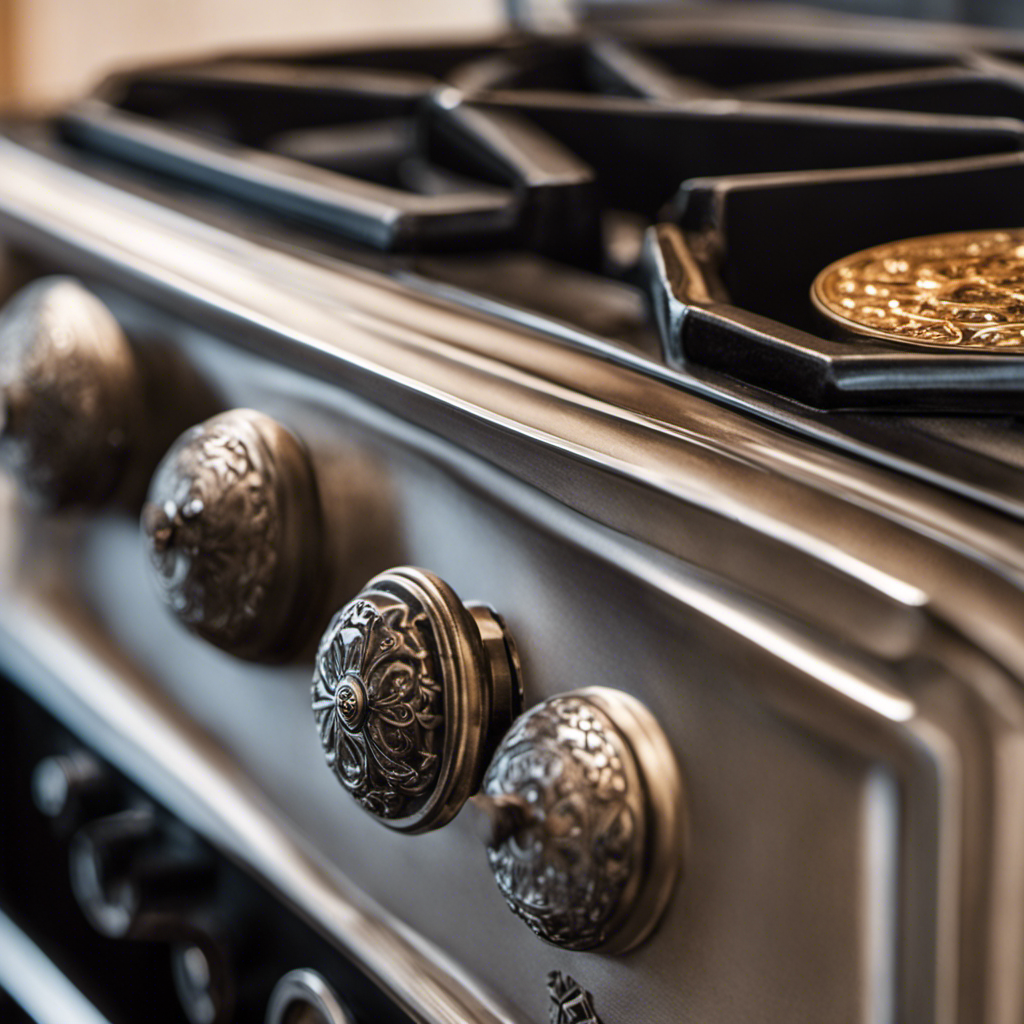
If you are the owner of a wood stove, have you ever questioned the function of the twistable knob?
Well, prepare to have your curiosity stoked. The twistable knob on a wood stove is like the conductor of an orchestra, controlling the airflow and ultimately the temperature inside your stove.
It’s a crucial instrument for achieving optimal heating efficiency. In this article, I will guide you through the purpose, function, and troubleshooting of this mysterious knob, ensuring you can make the most of your wood stove experience.
Key Takeaways
- The twistable knob on a wood stove controls airflow and heat output by adjusting the amount of oxygen entering the combustion chamber.
- It is connected to a damper that regulates air intake, opening the damper increases airflow and fire intensity, while closing it reduces airflow and fire intensity.
- Turning the twistable knob counterclockwise increases the temperature, while turning it clockwise decreases the temperature.
- Regular maintenance, including cleaning and lubrication, is necessary for proper functionality and optimizing the stove’s performance.
Understanding the Purpose of the Twistable Knob
I’m still not sure about the purpose of the twistable knob on a wood stove, but understanding its function seems crucial.
The twistable knob on a wood stove serves a vital role in controlling the airflow and heat output of the stove. It’s usually located on the front or side of the stove and can be easily adjusted to regulate the amount of oxygen that enters the combustion chamber. By turning the knob, you can increase or decrease the intensity of the fire, thus controlling the temperature inside the stove.
This feature is particularly useful for achieving optimal efficiency and preventing overheating. Different types of wood stove twistable knobs may include air intake knobs, damper knobs, and secondary air control knobs, each with their specific functions.
Proper maintenance and cleaning of wood stoves, including regular inspection and lubrication of the twistable knob, are essential to ensure its smooth operation and longevity.
How the Twistable Knob Controls Airflow
The twistable knob on a wood stove controls the airflow, allowing me to adjust the intensity of the fire. Understanding the mechanics of this twistable knob is essential to effectively control the combustion process in a wood stove.
The knob is connected to a damper, which regulates the amount of air that enters the stove. By twisting the knob, I can open or close the damper, thereby controlling the amount of oxygen that reaches the fire. Increasing the airflow by opening the damper will result in a more intense fire, while reducing the airflow by closing the damper will decrease the intensity.
This adjustment is crucial as it directly affects the combustion process. By managing the airflow, I can ensure efficient and clean burning, optimizing the stove’s performance.
Adjusting the Twistable Knob for Temperature Control
I can adjust the twistable knob by turning it counterclockwise to increase the temperature, or by turning it clockwise to decrease the temperature. The twistable knob is a crucial component of a wood stove as it allows me to control the amount of air reaching the fire, thus regulating the temperature. To ensure proper functionality and longevity of the twistable knob, regular maintenance is necessary. This includes checking for any debris or obstructions that may hinder its movement and cleaning it with a soft cloth. It’s also important to be aware of the different types of twistable knobs available. Some may have a simple design with arrows indicating the direction for temperature adjustment, while others may have numerical values for precise temperature control. Understanding the specific type of twistable knob on my wood stove will help me effectively adjust the temperature and maintain optimal performance.
| Types of Twistable Knobs |
|---|
| Simple Design |
| Numerical Adjustment |
| Color-Coded |
| Digital Display |
| Multi-Function |
The Importance of Properly Using the Twistable Knob
To effectively control the temperature of the wood stove, it’s crucial to properly turn and adjust the twistable knob.
The twistable knob on a wood stove is designed to regulate the airflow and therefore the heat output of the stove. It’s important to understand the mechanics of the knob and how it affects the stove’s performance.
Proper maintenance of the twistable knob is essential to ensure its smooth operation and prevent any malfunctions. Regular cleaning and lubrication are recommended to keep it functioning optimally.
Safety precautions must also be taken when handling the twistable knob. Always make sure to turn off the stove before adjusting the knob to avoid any accidents or burns.
Additionally, it’s important to be aware of the temperature range indicated on the knob and not exceed the recommended limits to prevent overheating or damage to the stove.
Troubleshooting Common Issues With the Twistable Knob
I’ve encountered several common issues with the twistable knob, such as it getting stuck or not turning smoothly. When faced with these problems, it’s essential to utilize troubleshooting techniques to address the issue effectively.
One common cause of a stuck twistable knob is the accumulation of debris or ash around the knob’s base. To resolve this, I recommend performing regular maintenance by cleaning the area around the knob using a soft brush or cloth.
Additionally, lubricating the knob’s mechanism with a high-quality graphite lubricant can improve its smooth operation. If the knob still refuses to turn smoothly, there might be a problem with the internal mechanism. In such cases, it’s advisable to seek professional assistance to avoid further damage.
Frequently Asked Questions
How Often Should I Adjust the Twistable Knob on My Wood Stove?
I adjust the twistable knob on my wood stove periodically to optimize heating efficiency. Cleaning the knob regularly ensures it functions properly. The twistable knob controls the airflow, allowing me to regulate the heat output of the stove.
Can I Use the Twistable Knob to Control the Intensity of the Fire?
Yes, the twistable knob on a wood stove can be used to control the intensity of the fire. By adjusting the knob, you can increase or decrease the amount of airflow to regulate the heat output.
What Happens if I Accidentally Break the Twistable Knob?
If the twistable knob on a wood stove is accidentally broken, it can be replaced. However, it is important to troubleshoot common issues with the knob first, such as checking for any debris or obstructions.
Is It Necessary to Have the Twistable Knob on a Wood Stove?
I wouldn’t dream of having a wood stove without the twistable knob. It’s absolutely necessary for controlling the airflow and regulating the temperature. Let me explain how this genius invention works.
Can the Twistable Knob Be Used to Control the Amount of Smoke Emitted From the Wood Stove?
Yes, the twistable knob on a wood stove can be used to control the amount of smoke emitted. By adjusting the knob, you can regulate the fire intensity, which directly affects the smoke production.
Does the Twistable Knob on a Wood Stove Affect the Amount of Ash Produced?
The twistable knob on a wood stove can indeed influence the amount of ash produced. By adjusting the knob, users can regulate the airflow and control the combustion process. Proper adjustment helps optimize burning efficiency and minimize excessive ash buildup in wood stoves, ensuring cleaner and more efficient heating.
Is a Catalytic or Non-Catalytic Wood Stove Better for Controlling Heat Output?
When it comes to controlling heat output, the choice between catalytic and non-catalytic wood stoves is a key factor. Catalytic vs non-catalytic wood stoves differ in their combustion process. Catalytic stoves use a catalyst to burn off smoke at lower temperatures, providing efficient and consistent heat. Non-catalytic stoves, on the other hand, provide a quicker and easier start-up but may have less precise heat control. Ultimately, the decision between the two depends on personal preferences and specific heating needs.
Conclusion
In conclusion, the twistable knob on a wood stove plays a crucial role in controlling the airflow and temperature within the stove. It acts as a metaphorical compass, guiding the user towards achieving the desired warmth and efficiency.
Just like a captain navigating through rough seas, understanding how to properly adjust and utilize the twistable knob is essential for a smooth and enjoyable wood stove experience.
So, remember to pay attention to this small but powerful tool to make the most out of your wood stove.
Growing up surrounded by the vast beauty of nature, Sierra was always drawn to the call of the wild. While others sought the comfort of the familiar, she ventured out, embracing the unpredictable and finding stories in the heartbeat of nature.
At the epicenter of every remarkable venture lies a dynamic team—a fusion of diverse talents, visions, and passions. The essence of Best Small Wood Stoves is crafted and refined by such a trio: Sierra, Logan, and Terra. Their collective expertise has transformed the platform into a leading authority on small wood stoves, radiating warmth and knowledge in equal measure.
Wood Stove
How To Remove Hearthstone Tribute Wood Stove Secondary Air Manifold
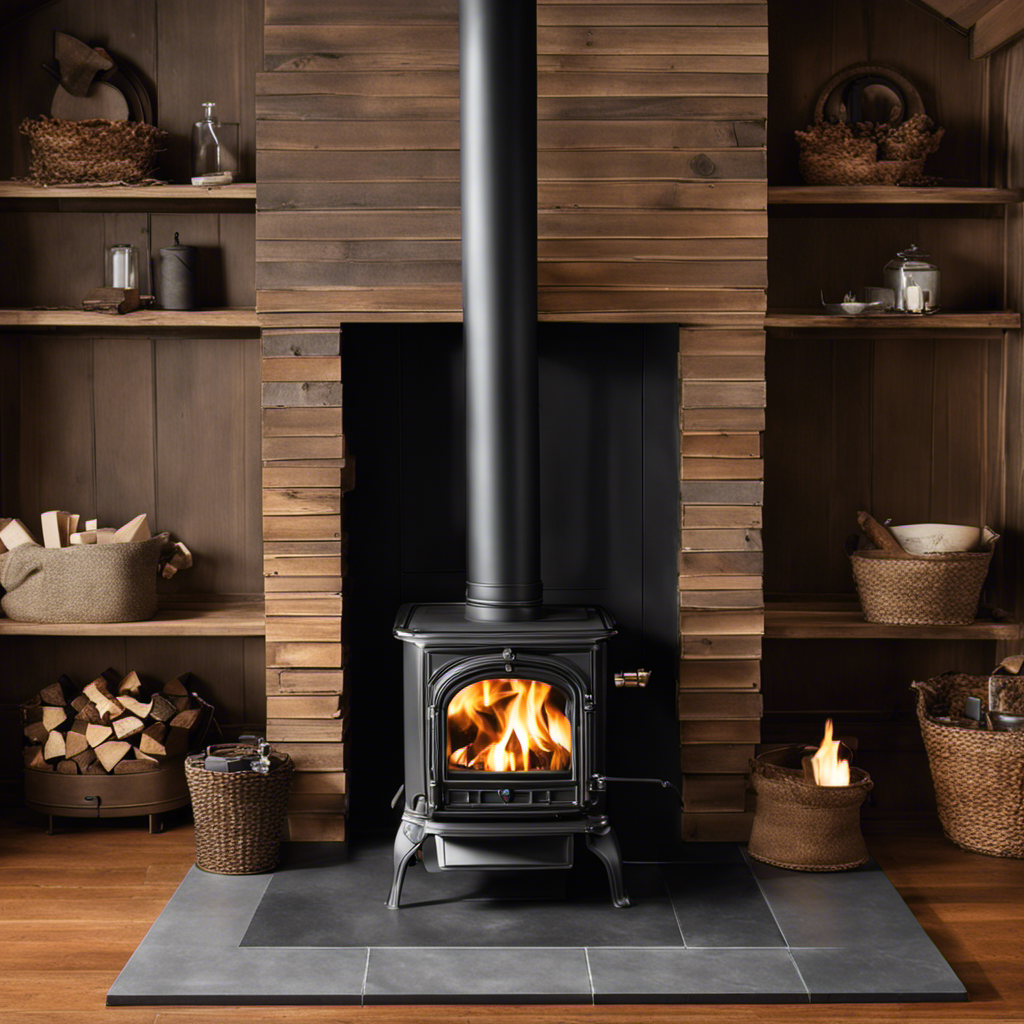
I’ve always enjoyed basking in the warm glow of my Hearthstone Tribute wood stove.
But recently, I noticed a decrease in its efficiency.
After some investigation, I discovered that the secondary air manifold might be clogged.
In this article, I’ll guide you through the process of removing the manifold, cleaning it, and inspecting for any issues.
By the end, your wood stove will be back to its optimal performance, keeping you cozy all winter long.
Key Takeaways
- Prepare the stove by cleaning it thoroughly and disconnecting power sources
- Use penetrating oil to loosen stuck or corroded bolts before removing the secondary air manifold
- Regularly clean and inspect the manifold for debris, soot buildup, cracks, and leaks
- When reinstalling the manifold, ensure the mating surfaces are clean, use a new gasket, and tighten the bolts evenly for a tight seal
Checking the Tools and Materials Needed
I need to make sure I’ve all the tools and materials required before starting the project. Safety precautions are essential when working with any heating appliance, so I’ll need safety goggles, gloves, and a dust mask to protect myself from any potential hazards.
Troubleshooting common issues may also require additional tools such as a flashlight, a screwdriver set, and pliers. It’s crucial to have these tools readily available to address any unexpected problems that may arise during the removal process.
Additionally, I’ll need to gather the necessary materials, including a new secondary air manifold, high-temperature silicone sealant, and a wire brush for cleaning.
Preparing the Stove for Manifold Removal
Before starting the removal process, it’s important to carefully clean the stove and disconnect the necessary components. This will ensure a smooth and efficient removal of the Hearthstone Tribute Wood Stove Secondary Air Manifold.
Here are a few key steps to follow when preparing the stove for removal:
-
Clean the stove thoroughly, removing any ash or debris that may have accumulated. This will prevent any dirt from entering the components during removal.
-
Disconnect the stove from any power sources and shut off the gas supply if applicable. Safety should always be the top priority when working with any appliance.
-
Troubleshoot common issues that may arise during removal, such as stuck or corroded bolts. Using penetrating oil and carefully applying pressure can help loosen stubborn parts.
Removing the Secondary Air Manifold
To successfully remove the secondary air manifold, carefully unscrew the bolts from the stove and gently slide it out from underneath the stove’s top plate.
The Hearthstone Tribute Wood Stove is a reliable and efficient heating source, but like any appliance, it may encounter common issues over time. Troubleshooting these issues is essential to ensure proper functioning.
Some common problems with the wood stove’s secondary air manifold include clogging and restricted airflow. Regular maintenance is key to maintaining the efficiency of the secondary air manifold.
It’s recommended to clean the manifold regularly by removing any buildup or debris. Additionally, checking for any leaks or cracks in the manifold and replacing damaged parts will help optimize its performance.
Cleaning and Inspecting the Manifold
The best way to ensure proper functioning of the secondary air manifold is to regularly clean and inspect it for any clogging or damage. The manifold plays a crucial role in the efficient operation of the wood stove, so it’s important to keep it in good condition.
Here are some key points to consider when inspecting the manifold:
-
Look for any signs of clogging, such as debris or soot buildup. A clogged manifold can restrict airflow and hinder the stove’s performance.
-
Check for any damage, such as cracks or leaks. These can lead to air leakage and affect the stove’s ability to generate heat.
-
Troubleshoot common issues, such as a misaligned or loose manifold. These problems can be easily fixed by adjusting or tightening the manifold.
Reinstalling the Secondary Air Manifold
After inspecting the secondary air manifold, I’ll reinstall it using a gasket and then secure it with bolts. When reinstalling the secondary air manifold, it’s important to ensure a proper seal to prevent any air leaks.
Start by cleaning the mating surfaces of the manifold and the stove body to remove any debris or old gasket material. Then, place a new gasket onto the manifold and align it with the bolt holes on the stove body. Carefully lower the manifold into position, making sure the gasket remains in place.
Once aligned, secure the manifold with the bolts, tightening them evenly to ensure a tight seal. Finally, check for any signs of air leaks and troubleshoot common issues such as loose bolts or a damaged gasket.
Frequently Asked Questions
How Long Does It Typically Take to Remove the Secondary Air Manifold From a Hearthstone Tribute Wood Stove?
Typically, it takes me about 15 minutes to remove the secondary air manifold from my Hearthstone Tribute wood stove. It’s a simple process that involves a few screws and careful maneuvering.
Can the Secondary Air Manifold Be Cleaned Without Removing It From the Stove?
Yes, the secondary air manifold can be cleaned without removing it from the stove. Regular maintenance and cleaning techniques for other parts of the wood stove are essential for optimal stove performance.
Is It Necessary to Inspect the Manifold for Any Specific Issues During the Cleaning Process?
Inspecting the manifold for specific issues during the cleaning process is necessary. Regularly inspecting the manifold is important to ensure its proper functioning and to identify any potential problems that may arise.
Are There Any Recommended Cleaning Agents or Solutions That Should Be Used When Cleaning the Secondary Air Manifold?
When cleaning the secondary air manifold of a Hearthstone Tribute Wood Stove, it is important to use recommended cleaning agents and follow the best cleaning techniques. This ensures a thorough and effective cleaning process.
Are There Any Common Mistakes to Avoid When Reinstalling the Secondary Air Manifold?
When reinstalling the secondary air manifold, it’s important to avoid common mistakes. One tip is to ensure a secure fit by tightening the screws evenly. Another is to double-check all connections for any leaks or gaps.
What is the Best Method to Remove Gunk from Wood Stove Windows?
When it comes to removing gunk from wood stove windows, there are several effective methods. One of the best approaches is to use a combination of vinegar and water. Simply mix equal parts of vinegar and water, apply the solution to the gunk, and let it sit for a few minutes. Then, scrub the residue off with a soft cloth or sponge. This method is not only affordable but also environmentally friendly.
Conclusion
After carefully removing and cleaning the secondary air manifold from your Hearthstone Tribute wood stove, you can reinstall it to ensure optimal performance.
Just like a conductor guiding an orchestra, the manifold plays a crucial role in directing the flow of air and fuel, enhancing the stove’s efficiency and heat output.
By maintaining and inspecting this component regularly, you can ensure that your wood stove continues to provide warmth and comfort for years to come.
Logan’s affair with adventure began in childhood. He hailed from a small town where vast forests bordered one side and endless shores stretched on the other. His days were spent exploring uncharted woods, climbing tall trees, or listening to the tales of old sailors. This early immersion in a world brimming with stories and mysteries became the foundation of his passion for writing.
-

 Wood Stove3 months ago
Wood Stove3 months agoHow To Build A Thermoelectric Generator For A Wood Stove
-
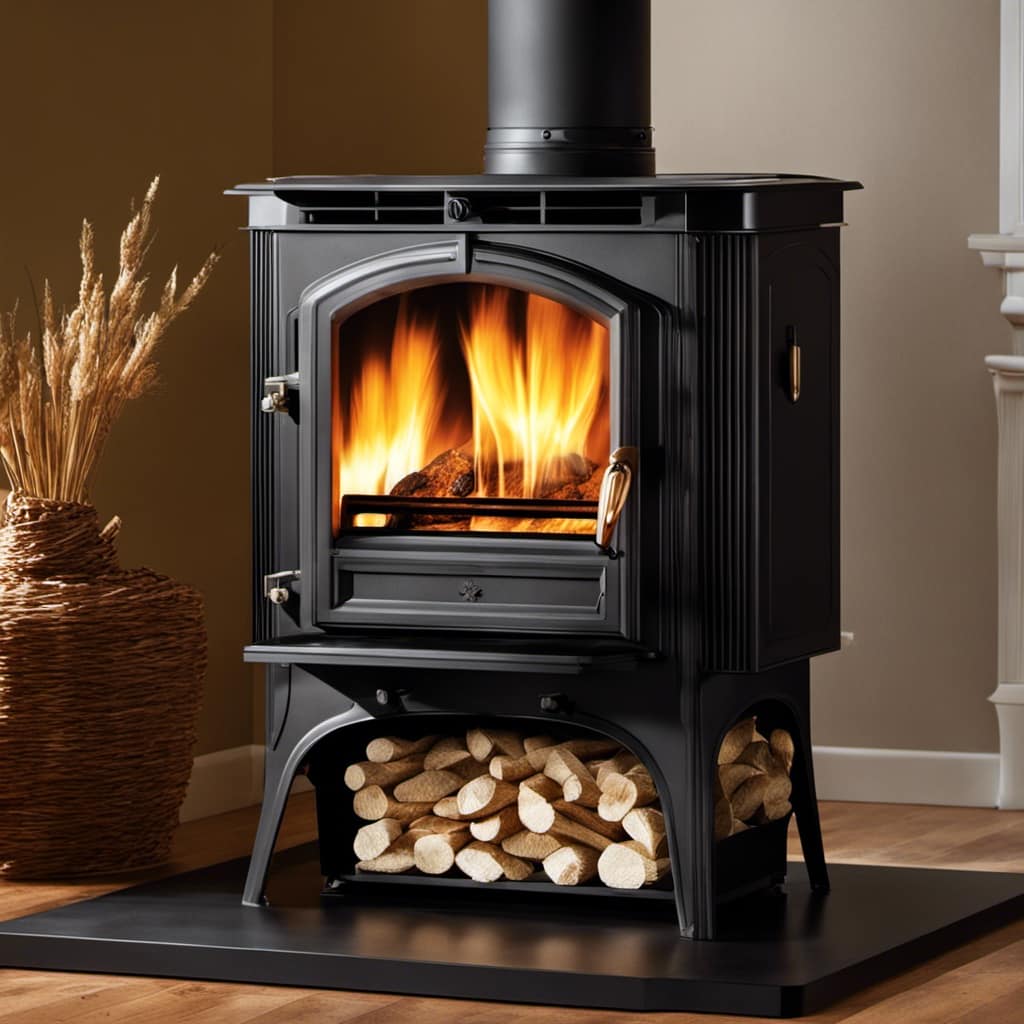
 Wood Stove4 months ago
Wood Stove4 months agoHow To Use Damper And Draft On Wood Stove
-

 Wood Stove4 months ago
Wood Stove4 months agoWhen To Open And Close Damper On Wood Stove
-

 Wood Stove3 months ago
Wood Stove3 months agoHow Far Does Wood Stove Have To Be From Wall
-

 Wood Stove3 months ago
Wood Stove3 months agoHow Does A Circulator Wood Stove Work
-
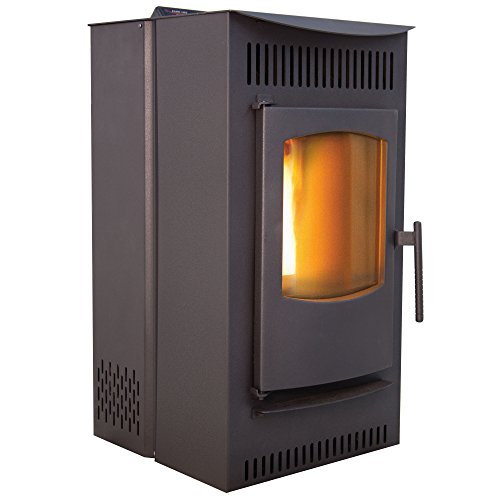
 Pellet Stoves3 months ago
Pellet Stoves3 months agoWhy Is My Wood Pellet Stove Putting so Much Soot
-
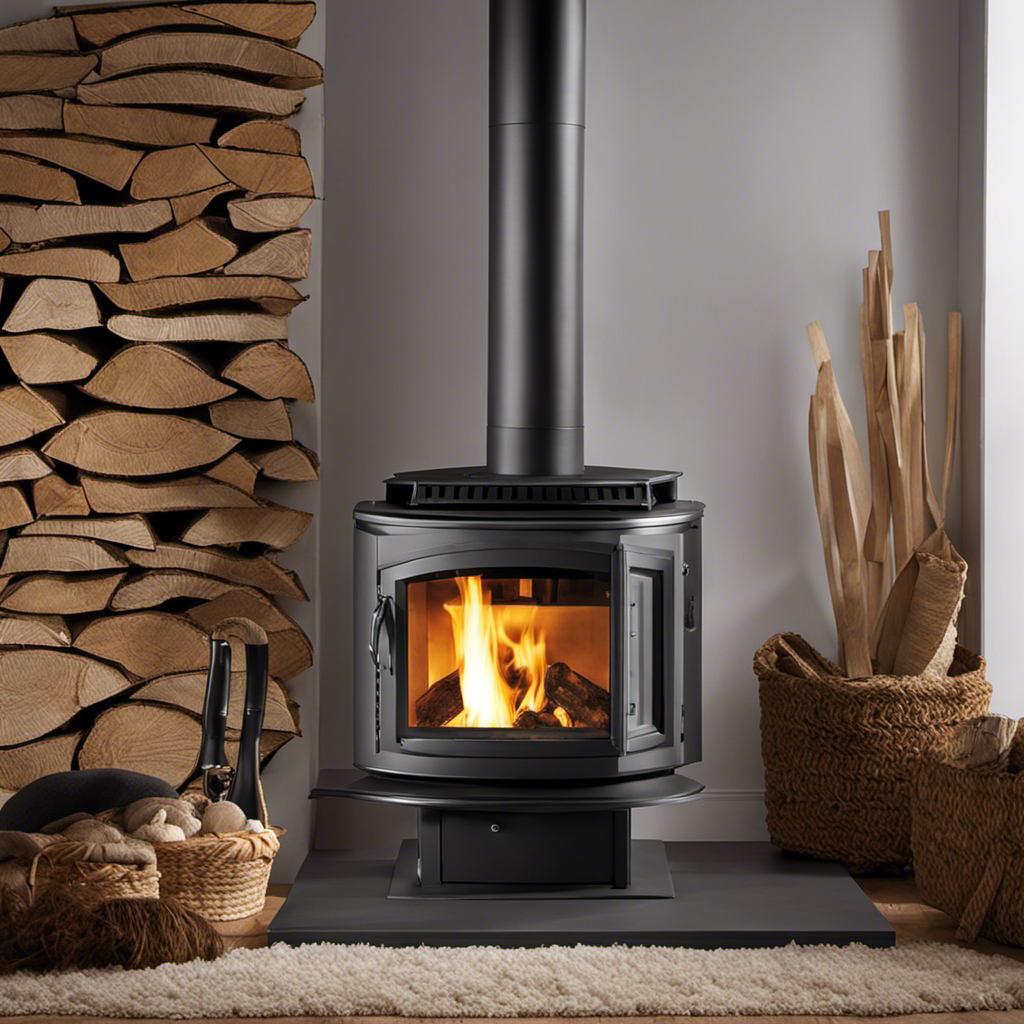
 Wood Stove4 months ago
Wood Stove4 months agoWhat Can I Use As Insulation On Wood Stove Pipes
-
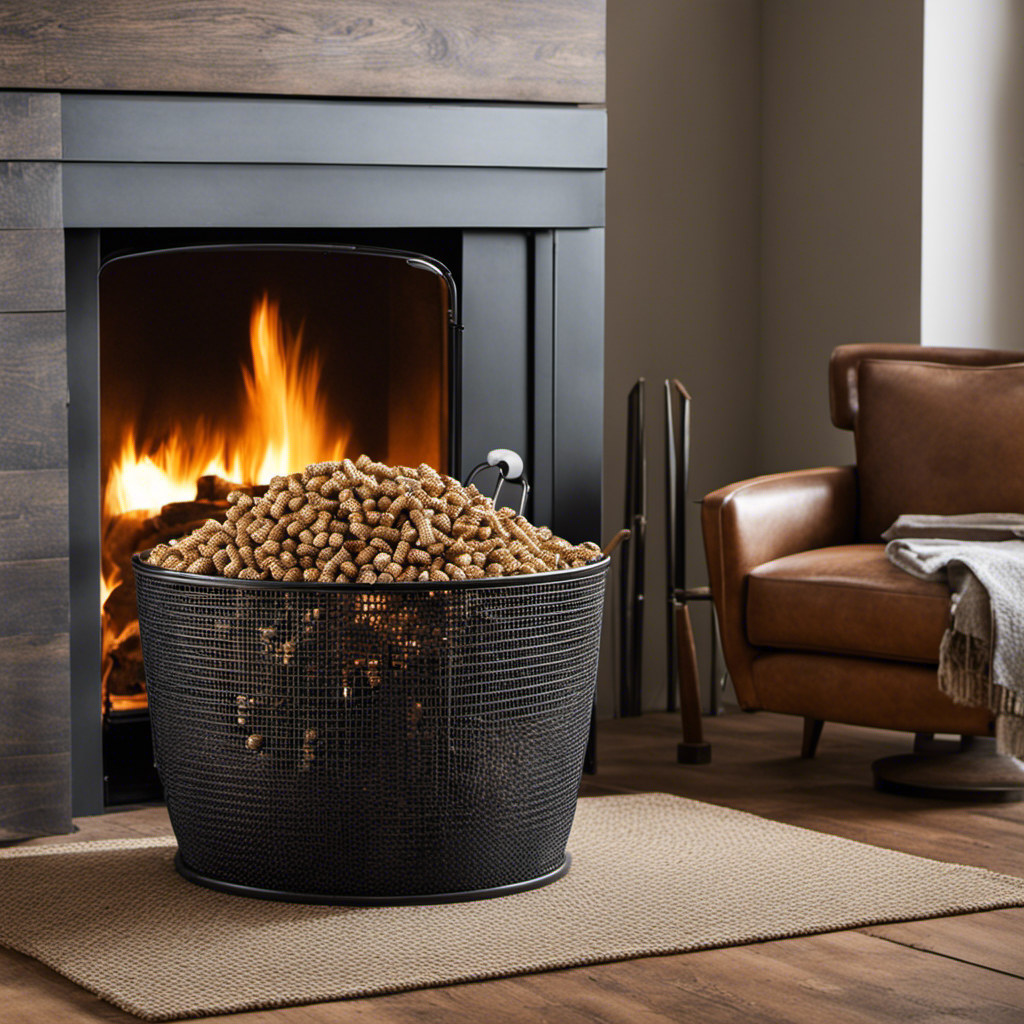
 Pellet Stoves3 months ago
Pellet Stoves3 months agoHow to Make a Pellet Basket for Wood Burning Stoves










